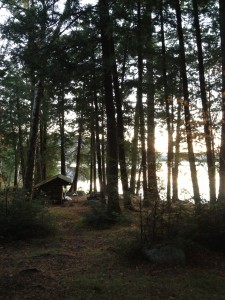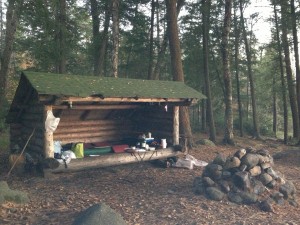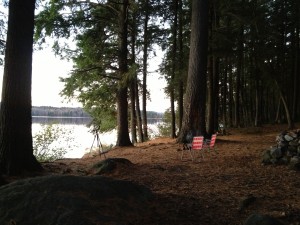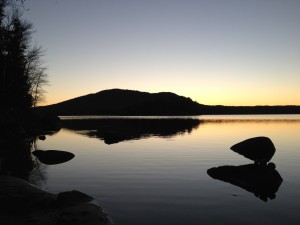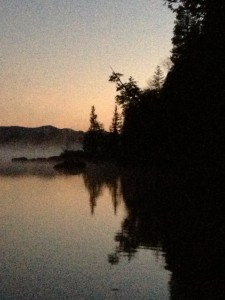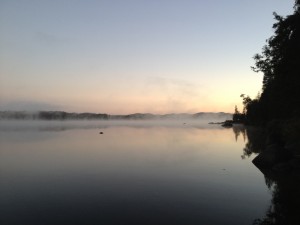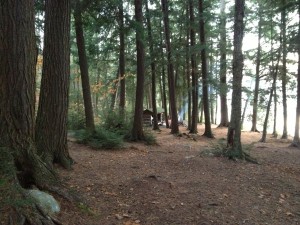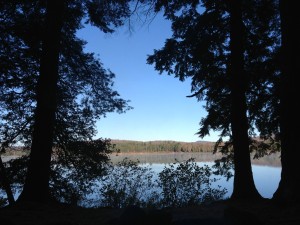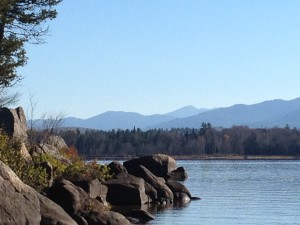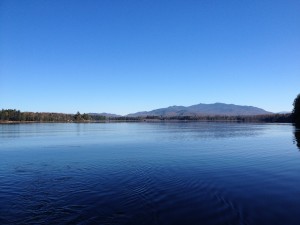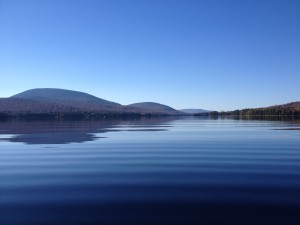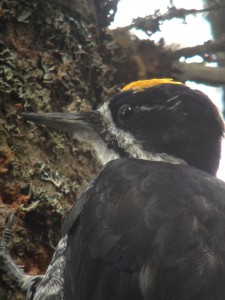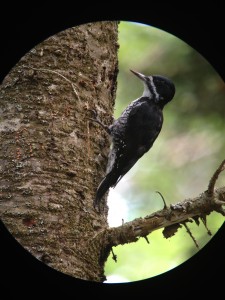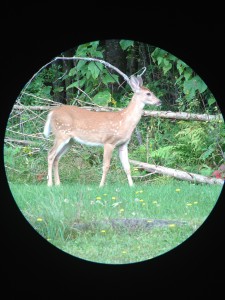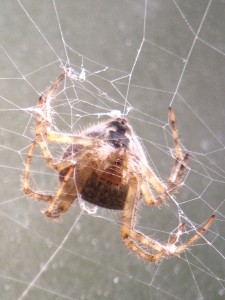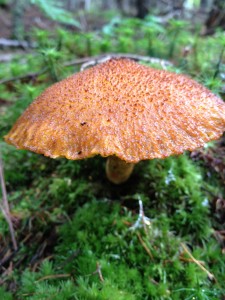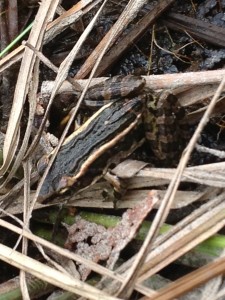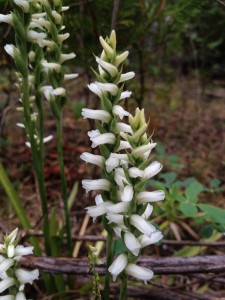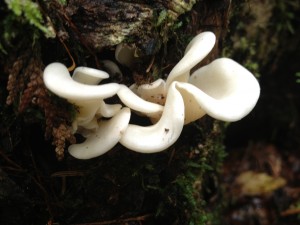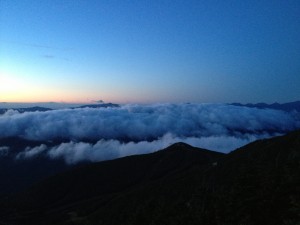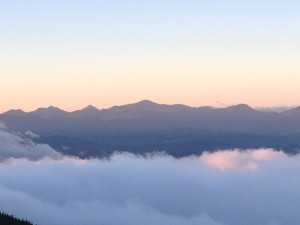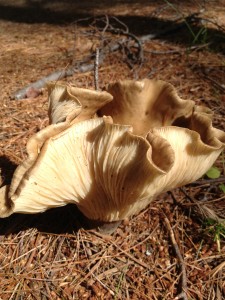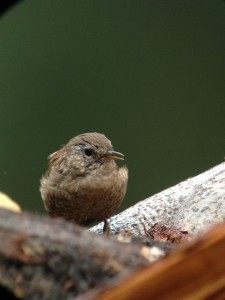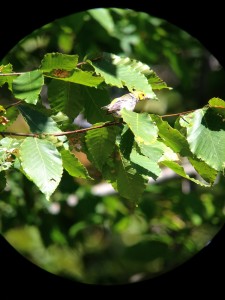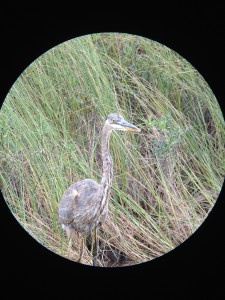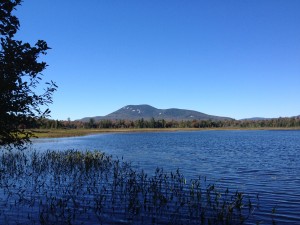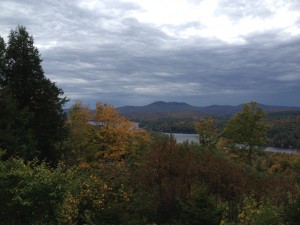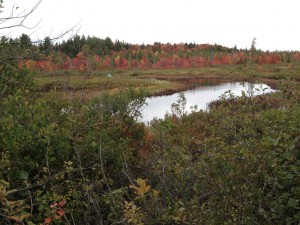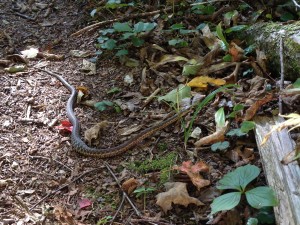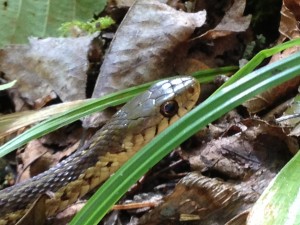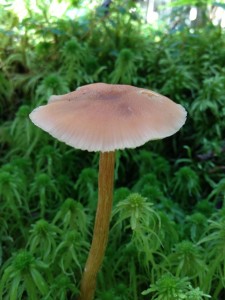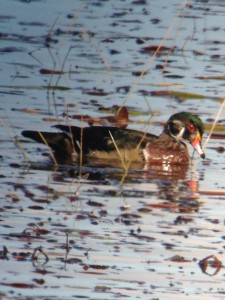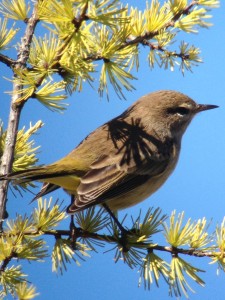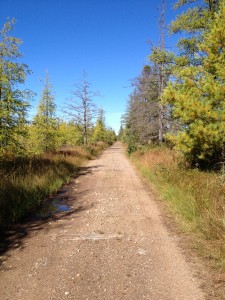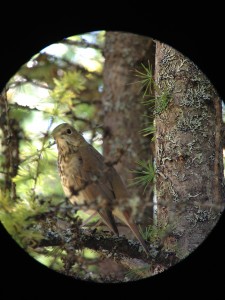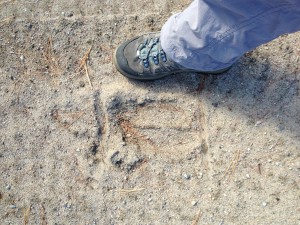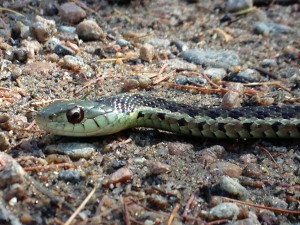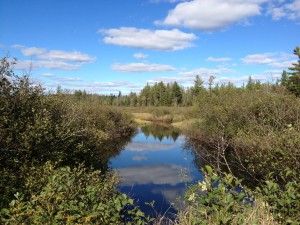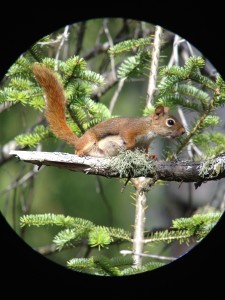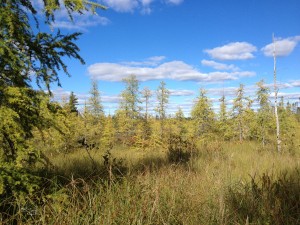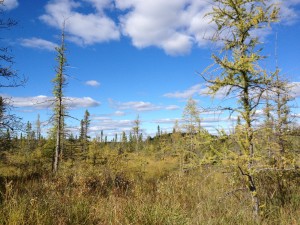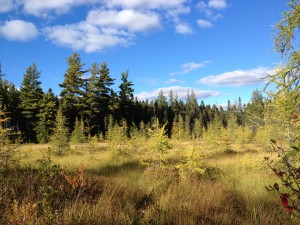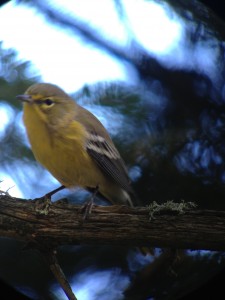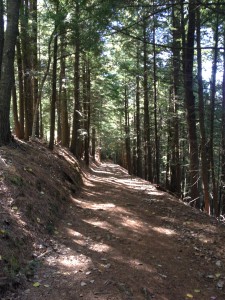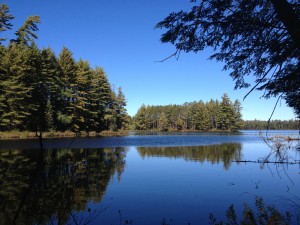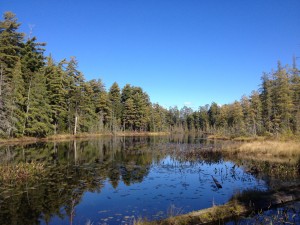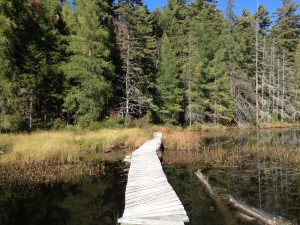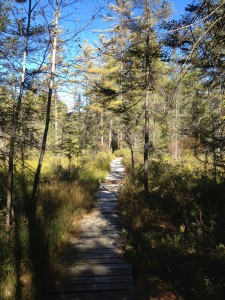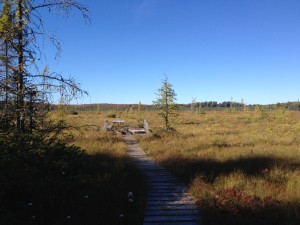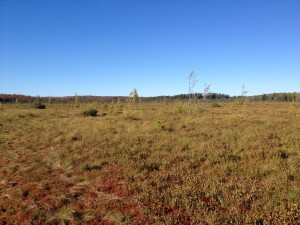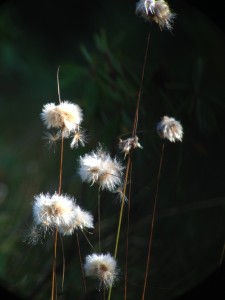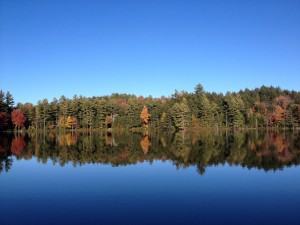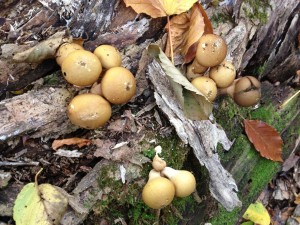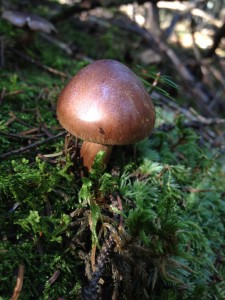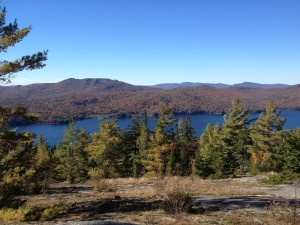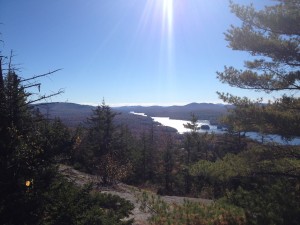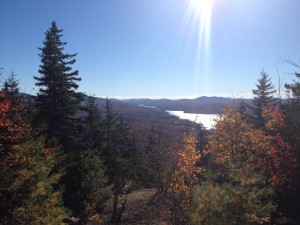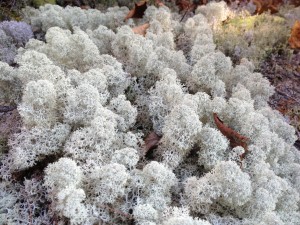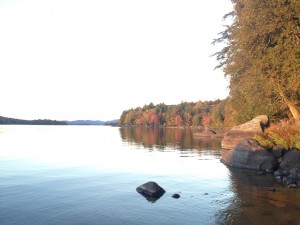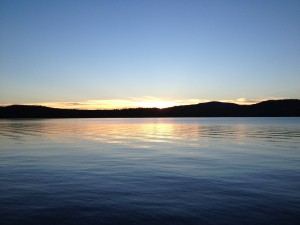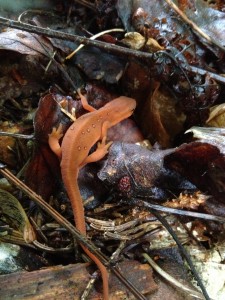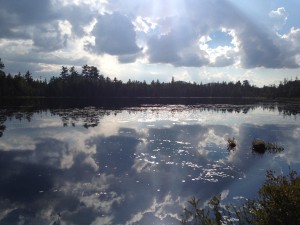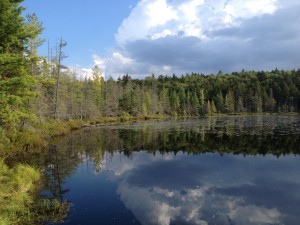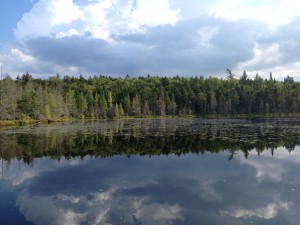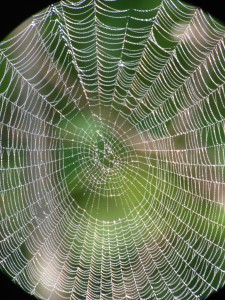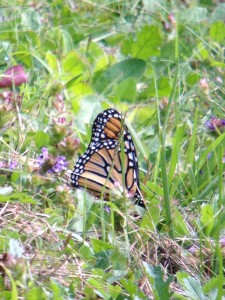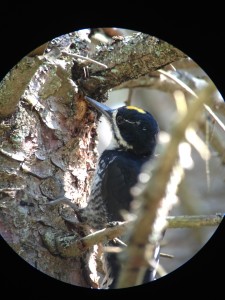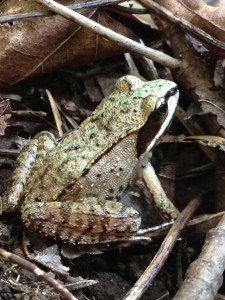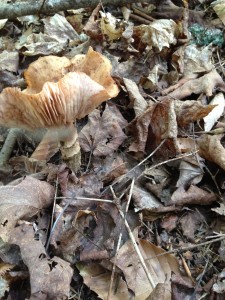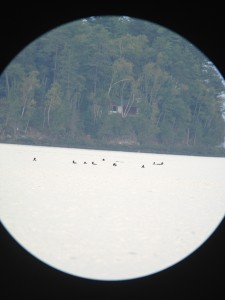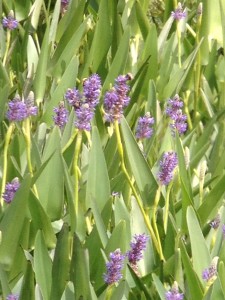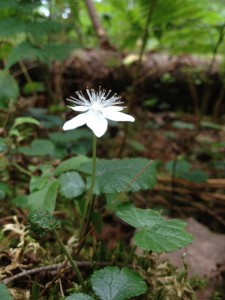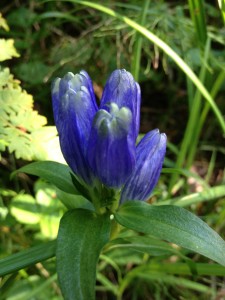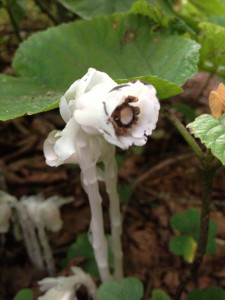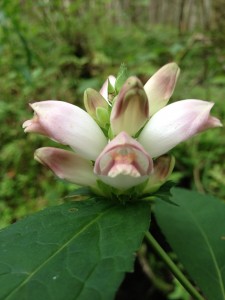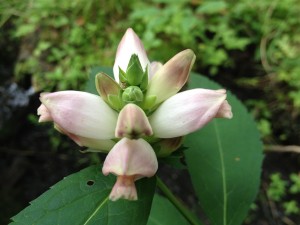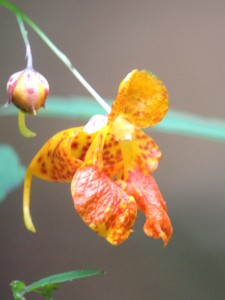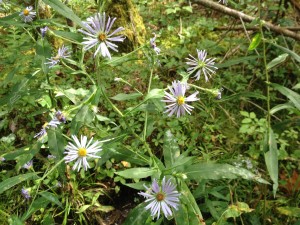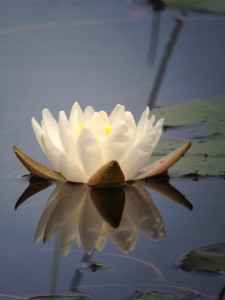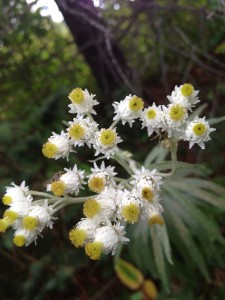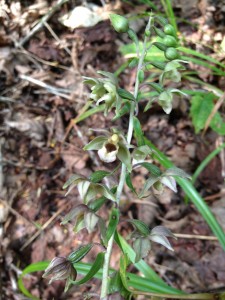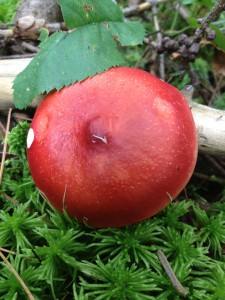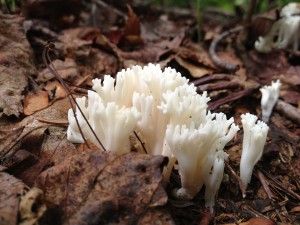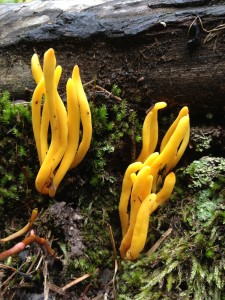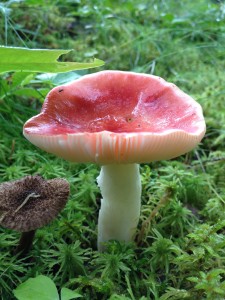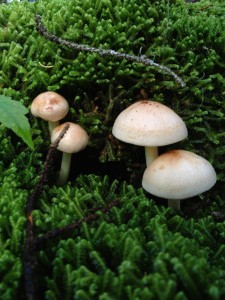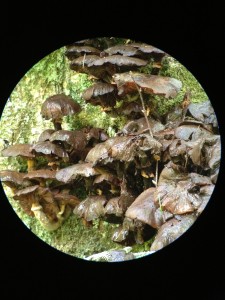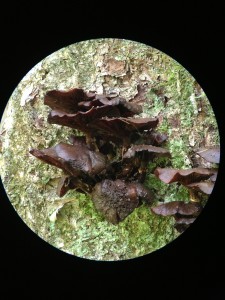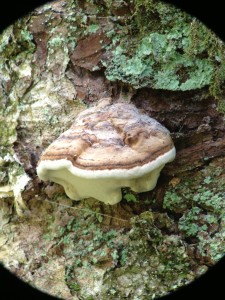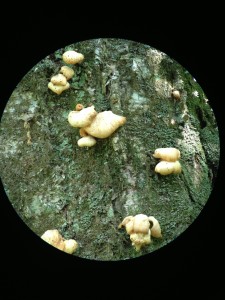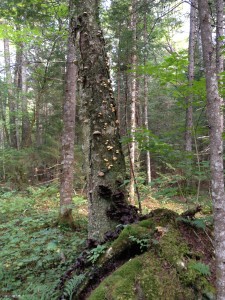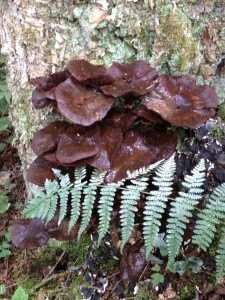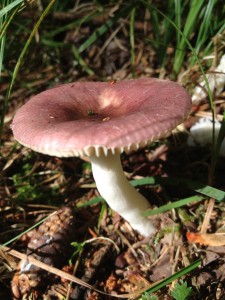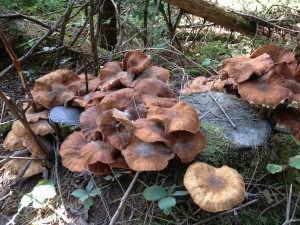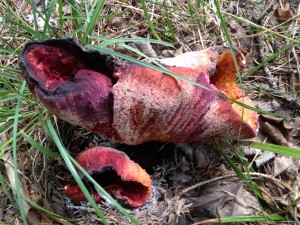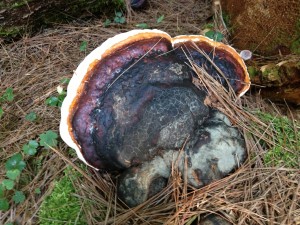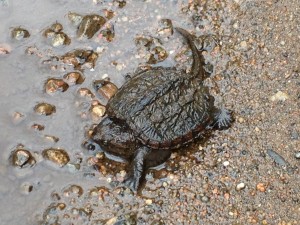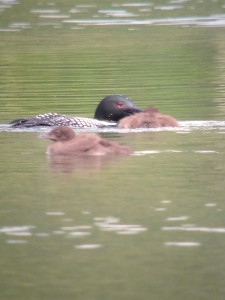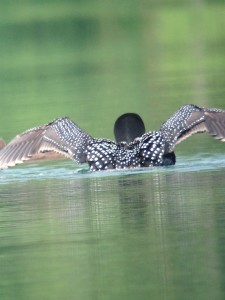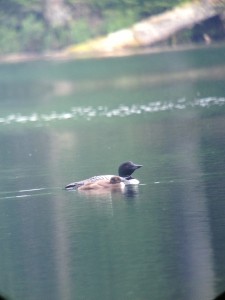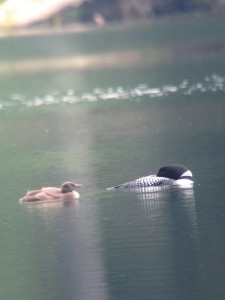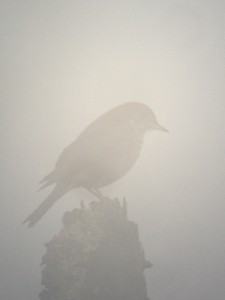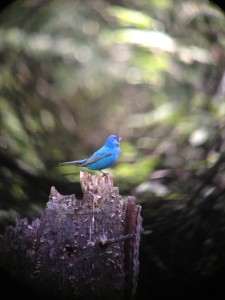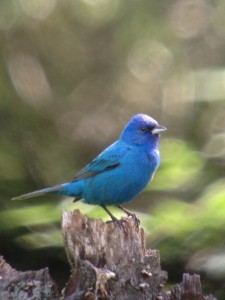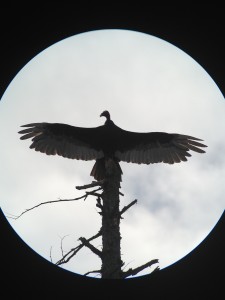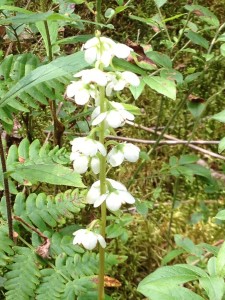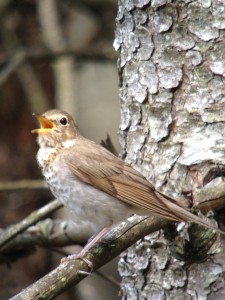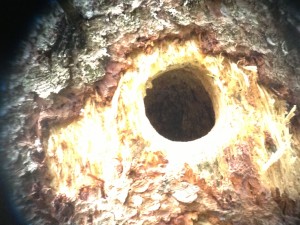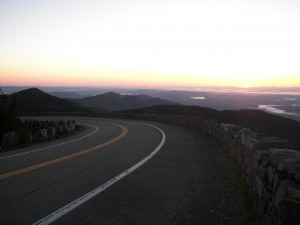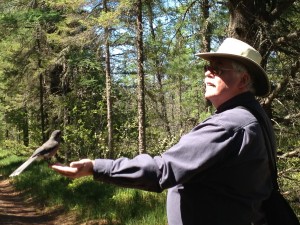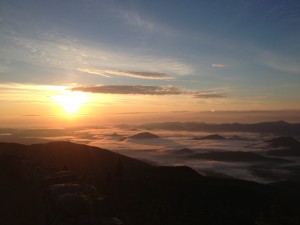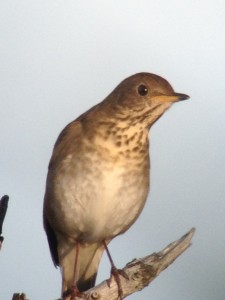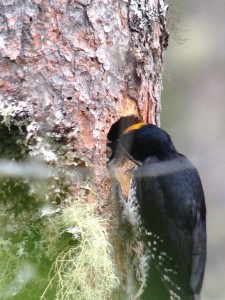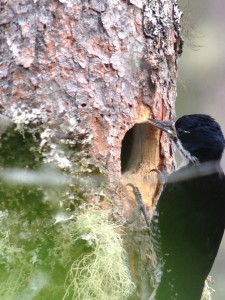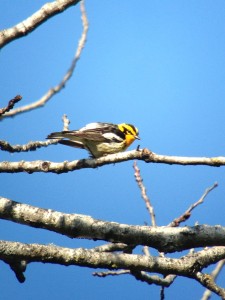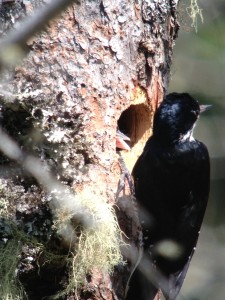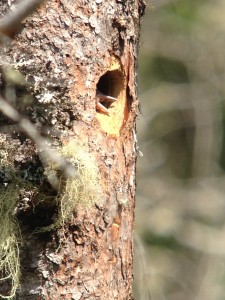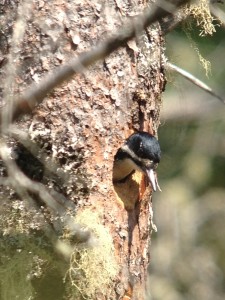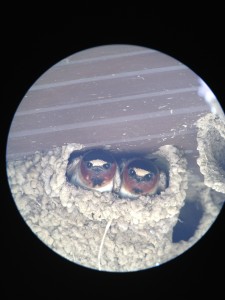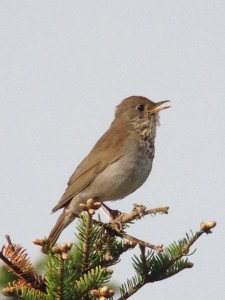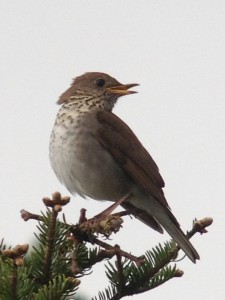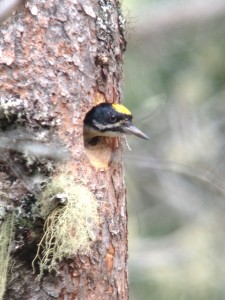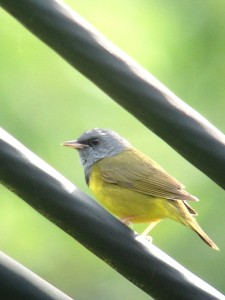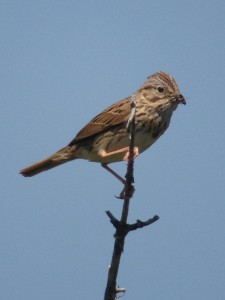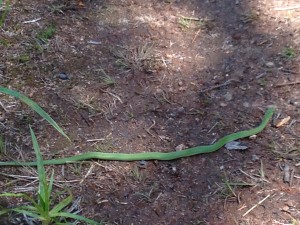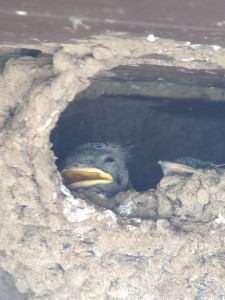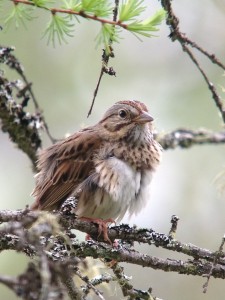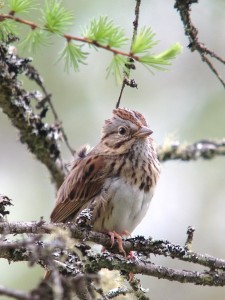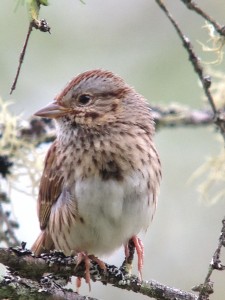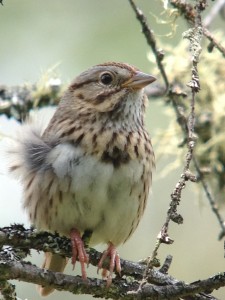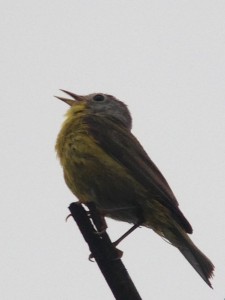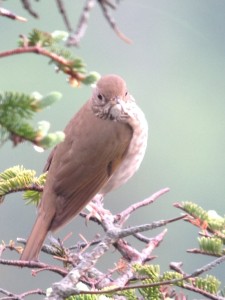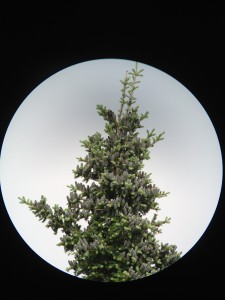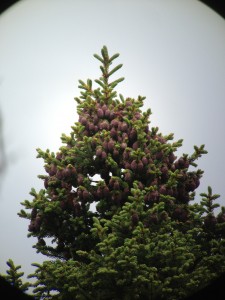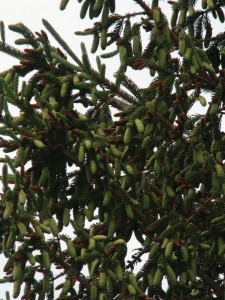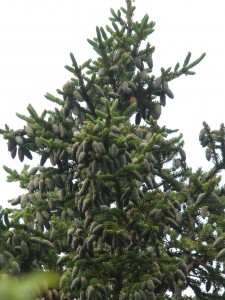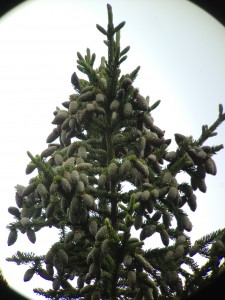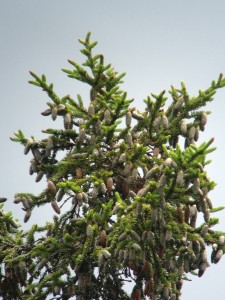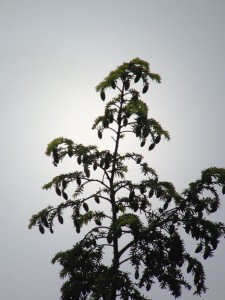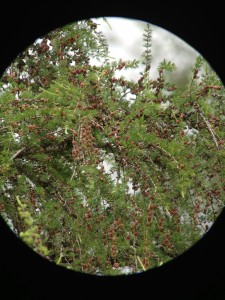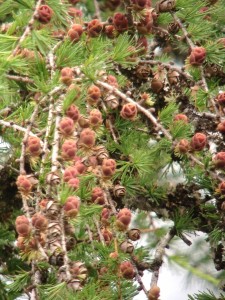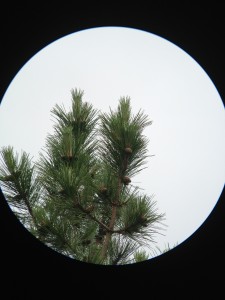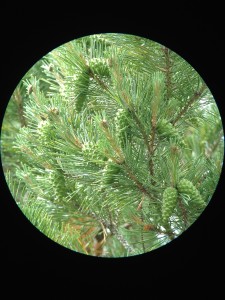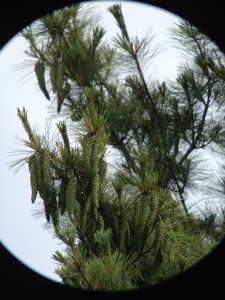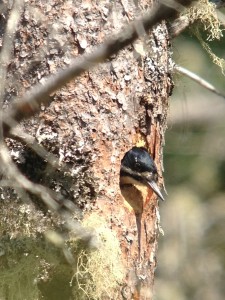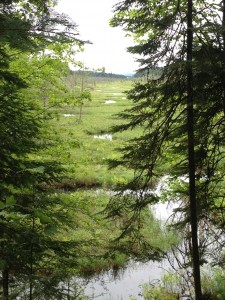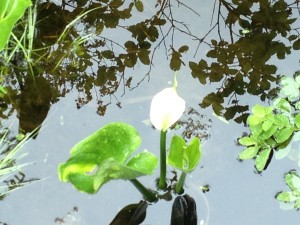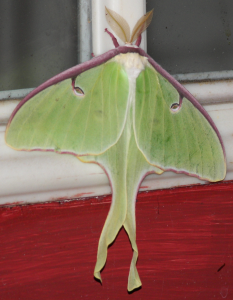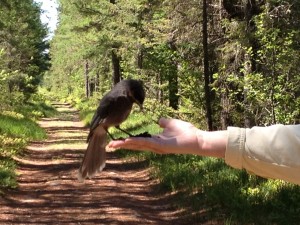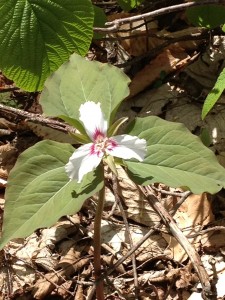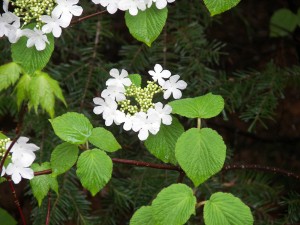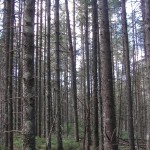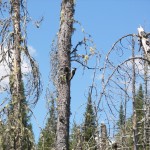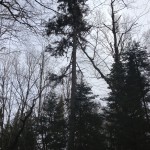Author Archive
Joan Collins is a blogger for ROOST (Regional Office of Sustainable Tourism) writing about many topics including birding, hiking, canoeing, camping, and cross country skiing. ROOST hosts many websites covering the Adirondack region. Links to Joan’s 2016 blogs (with lots of photos!) are below by region:
Adirondack Experience
Birding and Paddling Fishing Brook
http://www.adirondackexperience.com/blog/2016/10/birding-paddling-fishing-brook
Birding in March: A Transitional Time
http://www.adirondackexperience.com/blog/2016/03/birding-march-a-transitional-time
Birders Flock to the Central Adirondacks!
http://www.adirondackexperience.com/blog/2016/02/birders-flock-central-adirondacks
Exciting Winter Birding along Sabattis Circle Road
http://www.adirondackexperience.com/blog/2016/01/winter-birding-sabattis-circle-road
Climbing and Birding West Mountain
http://www.adirondackexperience.com/blog/2015/12/climbing-birding-west-mountain
Schroon Lake
A Boreal Birding Destination
http://www.schroonlakeregion.com/blog/2016/05/boreal-birding-destination
Great Winter Birding in Newcomb and Minerva
http://www.schroonlakeregion.com/blog/2016/03/winter-birding-newcomb-minerva
It’s Winter and Look Who’s Nesting!
http://www.schroonlakeregion.com/blog/2016/01/its-winter-and-look-whos-nesting
Lake Placid
A Record-Setting Year: 60th Saranac Lake Christmas Bird Count
http://www.lakeplacid.com/blog/2016/01/record-setting-60th-annual-christmas-bird-count
Tupper Lake
Sandhill Cranes Successfully Nest in the Adirondacks
http://www.tupperlake.com/blog/2016/09/sandhill-cranes-successfully-nest-adirondacks
Malone
Terrific Boreal Birding in Santa Clara!
http://www.visitmalone.com/blog/2016/01/terrific-boreal-birding-santa-clara
Joan Collins is a blogger for ROOST (Regional Office of Sustainable Tourism) writing about many topics including birding, hiking, canoeing, camping, and cross country skiing. ROOST hosts many websites covering the Adirondack region. Links to Joan’s 2015 blogs (with lots of photos!) are below by region:
Adirondack Experience
Lovely Views from the Summit of Mud Pond Mountain!
http://www.adirondackexperience.com/blog/2015/09/hike-bike-mud-pond-mountain
Why Birding and How Do I Start?
http://www.adirondackexperience.com/blog/2015/09/why-birding-and-how-do-i-start
Paddling Mud Pond in the Cedarlands Conservation Easement
http://www.adirondackexperience.com/blog/2015/07/paddling-mud-pond-cedarlands-conservation
A Beautiful Weekend for the 11th Annual Adirondack Birding Festival!
http://www.adirondackexperience.com/blog/2015/07/annual-adirondack-birding-festival
It’s Mud Season, and the Birding is Great!
http://www.adirondackexperience.com/blog/2015/04/great-birding-in-mud-season
Spring Skiing in the Round Lake Wilderness Area
http://www.adirondackexperience.com/blog/2015/04/spring-skiing-the-round-lake-wilderness-area
Ski from Inlet to Raquette Lake
http://www.adirondackexperience.com/blog/2015/03/ski-inlet-to-raquette-lake
A Fun Afternoon on the Three-Brook Loop Ski Trail
http://www.adirondackexperience.com/blog/2015/02/fun-xctry-ski-three-brook-loop-trail
One Bird to Look for this Winter
http://www.adirondackexperience.com/blog/2015/01/one-bird-to-look-winter
The Taming of the Shrewd Gray Jay
http://www.adirondackexperience.com/blog/2014/12/taming-the-shrewd-gray-jay
Schroon Lake
Boreal Birding in Newcomb and Minerva
http://www.schroonlakeregion.com/blog/2015/12/boreal-birding-newcomb-minerva
A Boreal Wonderful along the Roosevelt Truck Trail
http://www.schroonlakeregion.com/blog/2015/08/boreal-wonderland-roosevelt-truck-trail
Migration Celebration at the Adirondack Interpretive Center in Newcomb
Ski into the Past at Great Camp Santanoni
http://www.schroonlakeregion.com/blog/2015/01/ski-past-great-camp-santanoni
Saranac Lake
59th Saranac Lake Christmas Bird Count
http://www.saranaclake.com/blog/2015/01/saranac-lake-christmas-bird-count
Early May Wildflowers: A Kaleidoscope of Color
http://www.saranaclake.com/blog/2015/05/early-may-wildflowers-kaleidoscope-color
Tupper Lake
Spring Pond Bog: Beautiful Fall Boreal Birding
http://www.tupperlake.com/blog/2015/11/spring-pond-bog-fall-boreal-birding
Biking and Boreal Birding Massawepie Mire and Beyond
http://www.tupperlake.com/blog/2015/11/biking-boreal-birding-massawepie-mire-beyond
Leaf-Peeping & Birding Low’s Ridge – Upper Dam Trail
http://www.tupperlake.com/blog/2015/10/leaf-peeping-birding-lows-ridge-upper-dam-trail
Massawepie Lake: A Spectacular Canoe-Camping Adventure
http://www.tupperlake.com/blog/2015/09/massawepie-lake-canoe-camping
A Pair of Sandhill Cranes Summering in Tupper Lake!
http://www.tupperlake.com/blog/2015/09/pair-sandhill-cranes-summering-tupper-lake
The Mountaineer Trail: An Enchanting Place along Massawepie Lake!
http://www.tupperlake.com/blog/2015/05/mountaineer-trail-massawepie-lake
Mount Arab: A Fire Tower Peak and Museum!
http://www.tupperlake.com/blog/2015/05/mount-arab-fire-tower-peak-museum
Leonard Pond Trail: A Remote Cross-Country Ski
http://www.tupperlake.com/blog/2015/02/leonard-pond-trail-remote-xctry-ski
Malone
Snow Geese Spectacle!
http://www.visitmalone.com/blog/2015/10/snow-geese-spectacle
Joan Collins is a blogger for ROOST (Regional Office of Sustainable Tourism) writing about many topics including birding, hiking, canoeing, camping, and cross country skiing. ROOST hosts many websites covering the Adirondack region. Links to Joan’s 2014 blogs (with lots of photos!) are below by region:
Adirondack Experience
Hiking the Trails at Chain Lakes Road South
http://www.adirondackexperience.com/blog/2014/11/chain-lakes-road-south-opens-to-public
Canoe Camping on Lovely Lake Lila
http://www.adirondackexperience.com/blog/2014/10/the-lure-of-lovely-lake-lila
Canoe Camping on the Essex Chain Lakes
http://www.adirondackexperience.com/blog/2014/10/canoe-camping-the-essex-chain-lakes
Hike into Spectacular OK Slip Falls
http://www.adirondackexperience.com/blog/2014/10/hike-spectacular-ok-slip-falls
Lake Placid
Banding the Mysterious Northern Saw-whet Owl in Lake Placid
http://www.lakeplacid.com/blog/2014/11/banding-northern-saw-whet-owl
Tupper Lake
Birding in Tupper Lake: 5 Great Destinations!
http://www.tupperlake.com/blog/2014/11/birding-5-great-destinations
Species lists from September 2016 tours are below. Many photos from the trips are posted at https://www.facebook.com/adirondackavian
September 24, 2016
Field Trip on the Low’s Ridge – Upper Dam Trail sponsored by the Long Lake Parks and Recreation Department and Northern NY Audubon Society. Here is our list of 33 species (including some migrants):
Canada Goose
American Black Duck
Hooded Merganser – 2
Common Merganser – 2
Common Loon – 2 (one juvenile)
Great Blue Heron – on the drive
Bald Eagle – 4 (3 adults and 1 sub-adult)
Yellow-bellied Sapsucker
Hairy Woodpecker
Northern Flicker
Pileated Woodpecker
Eastern Phoebe
Blue-headed Vireo
Red-eyed Vireo
Gray Jay – 3
Blue Jay
Common Raven
Black-capped Chickadee
Red-breasted Nuthatch
Golden-crowned Kinglet
Ruby-crowned Kinglet (migrant)
Hermit Thrush – several
American Robin
Black-and-white Warbler
Blackpoll Warbler (migrant)
Black-throated Blue Warbler
Palm Warbler
Yellow-rumped Warbler
Black-throated Green Warbler
Song Sparrow
White-throated Sparrow
Dark-eyed Junco
American Goldfinch
*****
September 16, 2016
Fishing Brook paddle for a ROOST (Regional Office of Sustainable Tourism) blog. Here are the 25 species found along the brook:
Wood Duck
Pied-billed Grebe
Great Blue Heron
Hairy Woodpecker
Black-backed Woodpecker – 2 (1 female observed)
Northern Flicker
Pileated Woodpecker
Eastern Wood-Pewee
Eastern Phoebe
Blue-headed Vireo
Blue Jay
Black-capped Chickadee
Red-breasted Nuthatch
White-breasted Nuthatch
Brown Creeper
Golden-crowned Kinglet
Hermit Thrush
Gray Catbird
Cedar Waxwing
Common Yellowthroat
Song Sparrow
Swamp Sparrow
White-throated Sparrow
Rusty Blackbird – 4 (1 and 3)
Amer. Goldfinch
I also spent a long time with the largest Snapping Turtle I have ever encountered! There were many Moose paths along the brook. (This is also the location where I took all the Bull Moose photos posted to my Facebook page at: https://www.facebook.com/adirondackavian.)
*****
September 12, 2016
A half-day tour at Massawepie Mire with a mother and her remarkable 6 year-old daughter (a very serious birder and artist!) from Georgia. Here is our list of 44 species found:
Canada Goose
Wood Duck
American Black Duck
Mallard
Ruffed Grouse – on the dirt road on our drive out of Massawepie
Common Loon – in flight over Massawepie
Great Blue Heron – marsh in Tupper Lake along the causeway
Great Egret – marsh in Tupper Lake along the causeway
Turkey Vulture
Broad-winged Hawk
Belted Kingfisher – outside the Long Lake Diner at lunch!
Hairy Woodpecker
Northern Flicker
Pileated Woodpecker
American Kestrel – scope views of a perched bird at Massawepie
Yellow-bellied Flycatcher
Blue-headed Vireo
Gray Jay – 5 at Massawepie!
Blue Jay
American Crow
Common Raven
Black-capped Chickadee
Red-breasted Nuthatch
White-breasted Nuthatch
Winter Wren – brief view at Massawepie
Golden-crowned Kinglet
Hermit Thrush – nice views through the scope of 2 birds!
American Robin
Cedar Waxwing
Ovenbird
Nashville Warbler
Common Yellowthroat
Northern Parula
Black-throated Blue Warbler – singing
Palm Warbler – many; including singing birds
Pine Warbler – singing
Yellow-rumped Warbler
Black-throated Green Warbler – viewed along the drive out of Massawepie
Chipping Sparrow
Song Sparrow
White-throated Sparrow
Dark-eyed Junco
Red-winged Blackbird – 1
American Goldfinch
We also found an American Toad, Painted Turtle, and Black Bear scat!
*****
September 5, 2016
A tour with 3 birders (2 from East Hampton, NY and 1 from Colorado) in the boreal areas of the central Adirondacks including Massawepie Mire. Here is our list of 50 species:
Canada Goose
Wood Duck
American Black Duck
Ring-necked Duck
Wild Turkey
Common Loon
Pied-billed Grebe – Shaw Pond
Great Egret – at the Tupper Lake marsh; an unusual bird in our central Adirondack region!
Bald Eagle – 1 adult
Cooper’s Hawk – 1
Broad-winged Hawk – 2 different birds
Ring-billed Gull
Barred Owl – 4! (3 along Tarbell Hill Lane in Long Lake and 1 at Massawepie)
Belted Kingfisher – Shaw Pond
Yellow-bellied Sapsucker – juvenile
Hairy Woodpecker
Black-backed Woodpecker – 2 different birds (1 female and 1 male)
Northern Flicker
Pileated Woodpecker
American Kestrel – 2
Merlin – 2
Blue-headed Vireo
Red-eyed Vireo
Gray Jay – 10! (two groups of 3 at Massawepie, 3 at Sabattis Bog, and 1 flyover along Sabattis Circle Road)
Blue Jay
American Crow
Common Raven
Black-capped Chickadee
Boreal Chickadee – 4
Red-breasted Nuthatch
White-breasted Nuthatch
Winter Wren
Golden-crowned Kinglet
Hermit Thrush
American Robin
Gray Catbird
Cedar Waxwing
Ovenbird
Common Yellowthroat
Magnolia Warbler
Black-throated Blue Warbler
Palm Warbler – many!
Yellow-rumped Warbler
Song Sparrow
Lincoln’s Sparrow
White-throated Sparrow
Dark-eyed Junco
Purple Finch
Pine Siskin
American Goldfinch
We also found an Ermine, Fox (too far away to determine Red or Gray), and a lot of Black Bear scat!
Species lists from August 2016 tours are below. Many photos from the trips are posted at https://www.facebook.com/adirondackavian
August 25 & 26, 2016
Two early morning walks with guests at a privately rented Great Camp. Here is our list of 33 species by day:
Thursday, August 25, 2016 (24 species)
Common Loon – 3 adults
Great Blue Heron
Osprey – at least 2
Belted Kingfisher
Eastern Phoebe – singing
Blue-headed Vireo – singing
Blue Jay
American Crow
Common Raven
Black-capped Chickadee
Boreal Chickadee – at least 2!
Red-breasted Nuthatch
Brown Creeper
Winter Wren
Golden-crowned Kinglet
Cedar Waxwing
Common Yellowthroat
Northern Parula
Magnolia Warbler
Black-throated Blue Warbler
Yellow-rumped Warbler
Black-throated Green Warbler
Song Sparrow
White-throated Sparrow
Amphibian: American Toad
Mammals: Red Squirrel and a couple of Black Bear scats!
Wildflowers:
Labrador Tea
Pearly Everlasting
Yarrow
Goldenrod
Meadowsweet
Spatulate-leaved Sundew
Friday, August 26, 2016 (28 species)
Common Loon – 2 adults with a chick!
Osprey – calling
Belted Kingfisher
Hairy Woodpecker – family group
Northern Flicker
Yellow-bellied Flycatcher – 2 (one singing)
Blue-headed Vireo – singing
Red-eyed Vireo – singing
Blue Jay
American Crow
Common Raven
Black-capped Chickadee
Boreal Chickadee – at least 2!
Red-breasted Nuthatch
Brown Creeper
Golden-crowned Kinglet
Black-and-white Warbler
Common Yellowthroat
Magnolia Warbler
Black-throated Blue Warbler
Pine Warbler – several singing
Yellow-rumped Warbler
Black-throated Green Warbler
Chipping Sparrow
Song Sparrow
White-throated Sparrow
Dark-eyed Junco
American Goldfinch
Amphibian: American Toad
Reptile: Red-bellied Snake
Mammals: Red Squirrel and a couple of Black Bear scats!
Wildflowers:
Labrador Tea
Pearly Everlasting
Dewdrop
Goldenrod
Spatulate-leaved Sundew
*****
August 12, 2016
Early morning walk with guests at a privately rented Great Camp. Here is our list of species:
Birds:
Osprey – 3 (2 juveniles (one in the nest and one out) and an adult)
Belted Kingfisher
Black-backed Woodpecker – 1 heard calling
Eastern Phoebe
Red-eyed Vireo – singing
Blue Jay
Common Raven
Black-capped Chickadee
Red-breasted Nuthatch
Brown Creeper
Winter Wren – singing
Golden-crowned Kinglet
Hermit Thrush
Cedar Waxwing
Yellow-rumped Warbler
Canada Warbler – singing
Chipping Sparrow
Song Sparrow
White-throated Sparrow – singing
Dark-eyed Junco
Purple Finch
American Goldfinch
Amphibians:
American Toad
Wood Frog
Reptiles:
Common Gartersnake
Red-bellied Snake
Wildflowers:
Bunchberry – already in berry mode!
Spatulate-leaved Sundew – carnivorous bog plant
Yarrow
Wintergreen
Turtlehead
Pearly Everlasting
Meadowsweet
Spotted Joe-Pye Weed
Steeplebush
Common St. Johnswort
Goldenrod
Cow Vetch
New England Aster
Dewdrop
Labrador Tea
Arachnid:
Fishing Spider
*****
August 9, 2016
Roosevelt Truck Trail Field Trip sponsored by the Long Lake Parks and Recreation Department and Northern NY Audubon Society. Here is our list of 22 species:
Ruffed Grouse
Broad-winged Hawk
Yellow-bellied Sapsucker
Hairy Woodpecker
Black-backed Woodpecker – 2 heard calling
Blue-headed Vireo
Red-eyed Vireo
Blue Jay
Black-capped Chickadee
Boreal Chickadee – 6 (groups of 3, 1, and 2)
Red-breasted Nuthatch
Winter Wren – several
Golden-crowned Kinglet
Hermit Thrush
American Robin
Cedar Waxwing
Black-and-white Warbler
Black-throated Blue Warbler
Yellow-rumped Warbler
Dark-eyed Junco
Purple Finch
Amer. Goldfinch
Species lists from July 2016 tours are below. Many photos from the trips are posted at https://www.facebook.com/adirondackavian
July 28, 2016
A half-day tour with a family from Maryland in the Moose River Plains complex. Here are the 30 species found:
Yellow-bellied Sapsucker
Hairy Woodpecker
Northern Flicker – views
Yellow-bellied Flycatcher – singing
Alder Flycatcher – singing; nice view!
Blue-headed Vireo – views
Red-eyed Vireo
Blue Jay
Common Raven
Black-capped Chickadee
Boreal Chickadee – at least 5! Nice views of this flock!
Red-breasted Nuthatch
Brown Creeper
Golden-crowned Kinglet – views
Hermit Thrush – views
American Robin
Cedar Waxwing – nice views!
Black-and-white Warbler – views
Common Yellowthroat
Magnolia Warbler
Chestnut-sided Warbler – nice views!
Black-throated Blue Warbler
Yellow-rumped Warbler
Black-throated Green Warbler – views
Chipping Sparrow
Song Sparrow
Swamp Sparrow
White-throated Sparrow – views
Purple Finch
American Goldfinch
*****
July 24, 2016
A Dawn Tour up Whiteface Mountain followed by lowland boreal birding with 2 people from Westchester, NY. Here is our list of 53 species:
Canada Goose
Wood Duck – young at the marshes
American Black Duck – at the marshes
Osprey – nest in Long Lake
Bald Eagle – perched in a White Pine over Tupper Lake
Broad-winged Hawk – several heard and observed
Ruby-throated Hummingbird
Downy Woodpecker – on the summit of Whiteface! (unusual!)
Hairy Woodpecker
Northern Flicker
Pileated Woodpecker
Yellow-bellied Flycatcher – several heard with views of 2 (Whiteface Mountain and Route 30 in Long Lake)
Alder Flycatcher – many heard with views of one
Least Flycatcher – one heard singing
Eastern Kingbird – views in Tupper Lake at the marshes
Blue-head Vireo – including one on Whiteface’s summit!
Red-eyed Vireo
Gray Jay – 3 at Sabattis Bog including a juvenile
Blue Jay
American Crow
Common Raven – including a curious juvenile on the summit of Whiteface!
Tree Swallow
Barn Swallow
Black-capped Chickadee
Boreal Chickadee – 16!!! On the summit area of Whiteface – a new record for me (both for numbers found in one day and number found on the summit of Whiteface!)
Red-breasted Nuthatch
Brown Creeper
Winter Wren – many
Golden-crowned Kinglet
Ruby-crowned Kinglet – several heard on Whiteface with views of one
Eastern Bluebird – adults with young
Bicknell’s Thrush – many heard calling in the fog at dawn! (A beautiful moment!) One nice perched view and several flying views. A couple of distant songs heard, but the birds were mostly calling at dawn.
Swainson’s Thrush – many
Hermit Thrush – several
American Robin
Cedar Waxwing
Nashville Warbler – on Whiteface and in lowland habitat
Common Yellowthroat
Northern Parula
Magnolia Warbler – on Whiteface and in lowland habitat
Blackpoll Warbler – many with views of a few on Whiteface
Black-throated Blue Warbler
Palm Warbler – view at Sabattis Bog
Yellow-rumped Warbler – on Whiteface and in lowland habitat
Black-throated Green Warbler – on Whiteface and in lowland habitat
Chipping Sparrow
Song Sparrow
Lincoln’s Sparrow – singing at Sabattis Bog!
Swamp Sparrow
White-throated Sparrow – many; on Whiteface and in lowland habitat
Dark-eyed Junco – many
Red-winged Blackbird
American Goldfinch
We also saw a Snowshoe Hare on the summit area of Whiteface!
*****
July 20, 2016
A half-day tour in the central Adirondack boreal habitats with a couple from Ohio. Here is our list of 44 species:
Wood Duck – Shaw Pond
American Black Duck – Shaw Pond
Ruffed Grouse – female with at least 3 young in Minerva
Wild Turkey
Pied-billed Grebe – 1 at Shaw Pond
American Bittern – flyover along Route 30 in Long Lake
Great Blue Heron – Shaw Pond
Turkey Vulture
Osprey – adult soaring over its nest area (Minnow Pond along Route 30) and at least 2 young in the nest
Ruby-throated Hummingbird – marsh in Newcomb
Merlin – flyover
Alder Flycatcher – singing/calling – several at the marshes
Least Flycatcher – singing/calling at the intersection of Blue Ridge Road and Route 28N
Blue-headed Vireo
Red-eyed Vireo
Gray Jay – 2 along Route 30 near a marsh
Blue Jay
American Crow
Common Raven
Black-capped Chickadee
Boreal Chickadee – 2 birds heard
Red-breasted Nuthatch
Brown Creeper
Winter Wren – several singing birds
Golden-crowned Kinglet
Swainson’s Thrush – several singing and calling birds
Hermit Thrush – several singing and calling birds
American Robin
Cedar Waxwing
Black-and-white Warbler
Nashville Warbler
Common Yellowthroat
Northern Parula
Magnolia Warbler
Black-throated Blue Warbler
Yellow-rumped Warbler
Chipping Sparrow
Song Sparrow
Lincoln’s Sparrow – singing bird at Sabattis Bog – it had a very unusual vocalization!
Swamp Sparrow
White-throated Sparrow – many
Purple Finch
Red Crossbill – calling as they flew over Sabattis Bog!
American Goldfinch
*****
July 17, 2016
A birding tour in the central Adirondack boreal and marsh habitats with a birder from Rochester, NY. Here is our list of 64 species:
Canada Goose
Wood Duck – with babies!
American Black Duck
Mallard
Pied-billed Grebe – Shaw Pond
Great Blue Heron
Turkey Vulture
Ring-billed Gull
Belted Kingfisher
Yellow-bellied Sapsucker
Hairy Woodpecker
Black-backed Woodpecker – 1 male observed with another heard nearby
Northern Flicker – 3
Pileated Woodpecker
Merlin – likely nest site at the entrance to Massawepie
Yellow-bellied Flycatcher – Sabattis Bog
Alder Flycatcher – inlet of Little Tupper Lake
Eastern Phoebe
Eastern Kingbird
Blue-headed Vireo
Red-eyed Vireo
Gray Jay – 5 (2 along Route 30 and 3 at Sabattis Bog including a juvenile)
Blue Jay
American Crow
Common Raven
Tree Swallow
Barn Swallow
Black-capped Chickadee
Boreal Chickadee – 4
Red-breasted Nuthatch
Winter Wren
Golden-crowned Kinglet
Eastern Bluebird
Swainson’s Thrush
Hermit Thrush
American Robin
Gray Catbird
European Starling
Cedar Waxwing – many; views
Black-and-white Warbler
Nashville Warbler
Common Yellowthroat – nice view!
American Redstart
Northern Parula
Magnolia Warbler
Blackburnian Warbler
Yellow Warbler – views at the inlet of Little Tupper Lake
Chestnut-sided Warbler – views of a juvenile
Black-throated Blue Warbler
Palm Warbler – Sabattis Bog; nice view!
Pine Warbler
Yellow-rumped Warbler
Black-throated Green Warbler
Canada Warbler – nice view!
Chipping Sparrow
Song Sparrow
Lincoln’s Sparrow – Sabattis Bog
Swamp Sparrow
White-throated Sparrow
Dark-eyed Junco
Scarlet Tanager
Indigo Bunting – several along Massawepie Rd.
Red-winged Blackbird
Purple Finch – nice view!
*****
July 12, 2016
Spring Pond Bog Field Trip sponsored by the Long Lake Parks and Recreation Department and Northern NY Audubon Society. Here is our list of 36 species:
Ruffed Grouse
Spruce Grouse – observed by some!
Wild Turkey
Yellow-bellied Sapsucker
Hairy Woodpecker
Merlin
Yellow-bellied Flycatcher
Blue-headed Vireo
Red-eyed Vireo
Gray Jay – 2 (one juvenile)
Blue Jay
Common Raven
Black-capped Chickadee
Boreal Chickadee – 1
Red-breasted Nuthatch
Brown Creeper
Winter Wren
Golden-crowned Kinglet
Hermit Thrush
American Robin
Cedar Waxwing
Ovenbird
Nashville Warbler
Common Yellowthroat
Northern Parula
Magnolia Warbler
Blackburnian Warbler
Black-throated Blue Warbler
Palm Warbler
Yellow-rumped Warbler
Canada Warbler – male and female with food for young!
Savannah Sparrow – 2
Song Sparrow
Swamp Sparrow
White-throated Sparrow
Red-winged Blackbird
We also found a Red-bellied Snake!
*****
July 11, 2016
A Dawn Tour up Whiteface Mountain followed by lowland boreal birding with a couple from North Carolina. Here is our list of 74 species found:
Canada Goose
Wild Turkey – with young
Common Loon – 2 observed on Simon Pond in Tupper Lake, and some heard during the night
Great Blue Heron
Turkey Vulture
Osprey – at its nest
Broad-winged Hawk – nice view!
Virginia Rail – heard vocalizing at the Tupper Lake marsh during the night
Wilson’s Snipe – several calling and winnowing
American Woodcock – 1 heard vocalizing
Ring-billed Gull
Mourning Dove
Black-billed Cuckoo – 2! One heard at night by the Little Tupper Lake inlet and one observed foraging along River Road.
Chimney Swift
Belted Kingfisher – Route 30 marsh in Long Lake
Yellow-bellied Sapsucker
Hairy Woodpecker
Black-backed Woodpecker – 4! (2 observed – a male and a juvenile, with 2 more heard calling)
Northern Flicker
Olive-sided Flycatcher – at Sabattis Bog in Long Lake
Yellow-bellied Flycatcher
Alder Flycatcher – one heard at night at the Little Tupper Lake inlet
Least Flycatcher
Eastern Phoebe
Eastern Kingbird – near its nest on the Raquette River
Blue-headed Vireo
Red-eyed Vireo
Gray Jay – 14! (2 along Route 30 in Long Lake, 3 at Sabattis Bog, 3 off the Round Lake Trail, 5 at Bloomingdale Bog – 3 adults and 2 juveniles, and 1 observed on Bigelow Rd.)
Blue Jay
American Crow
Common Raven
Tree Swallow
Cliff Swallow
Barn Swallow
Black-capped Chickadee
Boreal Chickadee – 6!
Red-breasted Nuthatch
Winter Wren
Golden-crowned Kinglet
Ruby-crowned Kinglet
Bicknell’s Thrush – many! It was one of the best mornings on Whiteface all season!
Swainson’s Thrush
Hermit Thrush
American Robin
Gray Catbird
European Starling
Cedar Waxwing
Ovenbird
Black-and-white Warbler
Nashville Warbler
Mourning Warbler – lovely views!
Common Yellowthroat
American Redstart
Northern Parula
Magnolia Warbler
Blackburnian Warbler
Chestnut-sided Warbler
Blackpoll Warbler – many on Whiteface
Black-throated Blue Warbler
Palm Warbler
Pine Warbler
Yellow-rumped Warbler
Black-throated Green Warbler
Chipping Sparrow
Song Sparrow
Lincoln’s Sparrow
Swamp Sparrow
White-throated Sparrow
Dark-eyed Junco
Indigo Bunting – Sabattis Circle Road
Red-winged Blackbird
Common Grackle
Purple Finch
American Goldfinch
*****
July 8, 2016
A tour in the boreal habitat of the central Adirondacks with a birder from Washington, DC. Here is our list of 73 species:
Canada Goose
Wood Duck – Shaw Pond and Tupper Lake (with young)
Amer. Black Duck – with young on Tupper Lake
Ring-necked Duck – 2 on Tupper Lake
Hooded Merganser – 2 females on Upper Cat Pond
Ruffed Grouse – 5 young!
Wild Turkey – with young
Pied-billed Grebe – feeding 4 young on Shaw Pond
Amer. Bittern – heard at the marsh along Route 30 in Long Lake (location with 2 Grays Jays, and 1 Boreal Chickadee heard)
Turkey Vulture
Osprey – young in nest
Sharp-shinned Hawk – 1 carrying prey at Sabattis Bog
Broad-winged Hawk – 1 carrying prey
Sandhill Crane – 4 (Pair with 2 young)
Wilson’s Snipe – several calling and winnowing along Raquette River Drive
Mourning Dove
Belted Kingfisher
Yellow-bellied Sapsucker
Hairy Woodpecker
Black-backed Woodpecker – 2 drumming back and forth (1 called) at Sabattis Bog
Northern Flicker
Yellow-bellied Flycatcher
Least Flycatcher
Eastern Phoebe
Eastern Kingbird – including one at its nest along Raquette River Drive
Blue-headed Vireo
Philadelphia Vireo – heard singing in the Spring Pond Bog complex
Red-eyed Vireo
Gray Jay – 8
Blue Jay
American Crow
Common Raven
Tree Swallow
Barn Swallow
Black-capped Chickadee
Boreal Chickadee – 5
Red-breasted Nuthatch
Brown Creeper
Winter Wren
Golden-crowned Kinglet
Swainson’s Thrush
Hermit Thrush
Amer. Robin
Gray Catbird
Cedar Waxwing
Ovenbird
Black-and-white Warbler
Nashville Warbler
Mourning Warbler
Common Yellowthroat
American Redstart
Northern Parula
Magnolia Warbler
Blackburnian Warbler
Yellow Warbler
Chestnut-sided Warbler
Black-throated Blue Warbler
Palm Warbler
Pine Warbler
Yellow-rumped Warbler
Black-throated Green Warbler
Canada Warbler
Chipping Sparrow
Song Sparrow
Lincoln’s Sparrow – Sabattis Bog
Swamp Sparrow
White-throated Sparrow
Scarlet Tanager
Rose-breasted Grosbeak
Indigo Bunting
Red-winged Blackbird
Purple Finch
Amer. Goldfinch
*****
July 5, 2016
A half-day walk at a privately rented Great Camp. Here is our species list:
Birds:
Common Loon – 2
Osprey – 2 adults w/young in a nest
Broad-winged Hawk
Yellow-bellied Sapsucker
Black-backed Woodpecker – heard (& observed by a couple people)
Yellow-bellied Flycatcher
Least Flycatcher
Blue-headed Vireo
Red-eyed Vireo
Blue Jay
Common Raven
Black-capped Chickadee
Brown Creeper
Winter Wren
Golden-crowned Kinglet
American Robin
Cedar Waxwing
Ovenbird
Black-and-White Warbler
Nashville Warbler
Common Yellowthroat
Northern Parula
Magnolia Warbler
Blackburnian Warbler
Black-throated Blue Warbler
Yellow-rumped Warbler
Black-throated Green Warbler
Canada Warbler
Chipping Sparrow
Song Sparrow
White-throated Sparrow
Dark-eyed Junco
Also:
Amphibians:
American Toad
Wood Frog
Reptiles:
Common Garter Snake
Wildflowers:
Spatulate-leaved Sundew
Bunchberry
Blue Flag (also known as Wild Iris)
Common Fleabane
Common Wood Sorrel
Sheep Laurel
Yellow Pond Lily
Orange Hawkweed
Cow Vetch
*****
July 2, 3, & 4, 2016
A 3-day tour with a group from NYC Audubon in many different Adirondack habitats (bogs, boreal forest, marshes, etc.) including a Dawn Tour up Whiteface Mountain. Here is our list of 86 species (by day):
July 2, 2016 (65 species):
Ruffed Grouse – 2 different adults and chicks (1 with 1 chick, and 1 with 3 chicks)
Wild Turkey
Common Loon – on Deer Pond along Massawepie Rd.
Turkey Vulture
Ring-billed Gull
Mourning Dove
Chimney Swift
Ruby-throated Hummingbird
Belted Kingfisher
Yellow-bellied Sapsucker
Down Woodpecker
Hairy Woodpecker
Black-backed Woodpecker – male
Northern Flicker
Least Flycatcher
Eastern Phoebe
Blue-headed Vireo
Philadelphia Vireo – singing; observed by a couple
Red-eyed Vireo
Blue Jay
American Crow
Common Raven
Tree Swallow
Barn Swallow
Black-capped Chickadee
Red-breasted Nuthatch
White-breasted Nuthatch
Brown Creeper
Winter Wren
Golden-crowned Kinglet
Veery
Hermit Thrush
Wood Thrush
American Robin
Gray Catbird
European Starling
Cedar Waxwing
Ovenbird
Northern Waterthrush – observed
Black-and-white Warbler
Nashville Warbler
Mourning Warbler – nice views!
Common Yellowthroat
American Redstart
Northern Parula
Magnolia Warbler
Blackburnian Warbler
Chestnut-sided Warbler
Black-throated Blue Warbler
Palm Warbler
Pine Warbler
Yellow-rumped Warbler
Black-throated Green Warbler
Chipping Sparrow
Song Sparrow
Lincoln’s Sparrow
Swamp Sparrow
White-throated Sparrow
Dark-eyed Junco
Rose-breasted Grosbeak
Indigo Bunting
Common Grackle
Purple Finch
Red Crossbill – 4! (calling and observed flying over us during a stop to view a Ruffed Grouse with young)
Amer. Goldfinch
July 3, 2016 (70 species):
Canada Goose
Ruffed Grouse – with young!
Wild Turkey
Common Loon – 7 (4 on Simon Pond, 1 flyover at the Tupper Lake causeway, 1 on Tupper Lake, and 1 on Long Lake)
Great Blue Heron
Turkey Vulture
Bald Eagle
Broad-winged Hawk
Sandhill Crane – 4 (including 2 juveniles)! (First confirmed breeding record in the Adirondacks!)
Wilson’s Snipe
Herring Gull
Mourning Dove
Chimney Swift
Ruby-throated Hummingbird
Yellow-bellied Sapsucker – at a nest along Sabattis Circle Road
Hairy Woodpecker
Black-backed Woodpecker – 1 male along Route 30 (where we stopped to feed Gray Jays and heard & observed Boreal Chickadees) and 1 flyover at the marsh in Newcomb (near a nest area where the young recently fledged)
Olive-sided Flycatcher – heard calling at Sabattis Bog
Yellow-bellied Flycatcher
Least Flycatcher
Eastern Phoebe
Eastern Kingbird – several, including one at a nest location
Blue-headed Vireo
Red-eyed Vireo
Gray Jay – 5 (3 at Sabattis Bog and 2 along Route 30)
Blue Jay
American Crow
Common Raven
Tree Swallow – with young!
Barn Swallow
Black-capped Chickadee
Boreal Chickadee – 6
Red-breasted Nuthatch
Winter Wren
Golden-crowned Kinglet
Swainson’s Thrush
Hermit Thrush
American Robin
Gray Catbird
European Starling
Cedar Waxwing
Ovenbird
Black-and-white Warbler
Nashville Warbler
Mourning Warbler – at least 2 heard singing along Sabattis Circle Road in Long Lake
Common Yellowthroat
American Redstart
Northern Parula
Magnolia Warbler
Blackburnian Warbler
Yellow Warbler
Chestnut-sided Warbler
Black-throated Blue Warbler
Palm Warbler
Pine Warbler
Yellow-rumped Warbler
Black-throated Green Warbler
Canada Warbler – several at Sabattis Bog
Chipping Sparrow
Song Sparrow
Lincoln’s Sparrow – views at Sabattis Bog
Swamp Sparrow
White-throated Sparrow
Dark-eyed Junco
Indigo Bunting
Red-winged Blackbird
Common Grackle
Purple Finch
White-winged Crossbill – heard calling at Sabattis Bog (where they nested this winter)
Amer. Goldfinch
July 4, 2016 (51 species):
Broad-winged Hawk
Mourning Dove
Yellow-bellied Sapsucker
Black-backed Woodpecker – 1
Northern Flicker
Yellow-bellied Flycatcher
Least Flycatcher
Blue-headed Vireo
Red-eyed Vireo
Gray Jay – 6
Blue Jay
American Crow
Common Raven
Tree Swallow
Cliff Swallow – at their nests!
Barn Swallow – including fledglings!
Red-breasted Nuthatch
Winter Wren
Golden-crowned Kinglet
Ruby-crowned Kinglet
Eastern Bluebird
Bicknell’s Thrush – nice views, including a bird collecting food; lots of calling birds and a few songs
Swainson’s Thrush
Hermit Thrush
American Robin
European Starling
Cedar Waxwing
Ovenbird
Black-and-white Warbler
Nashville Warbler
Mourning Warbler – singing
American Redstart
Northern Parula
Magnolia Warbler
Blackburnian Warbler
Chestnut-sided Warbler
Blackpoll Warbler – several views
Black-throated Blue Warbler
Palm Warbler
Yellow-rumped Warbler
Black-throated Green Warbler
Chipping Sparrow
Savannah Sparrow
Song Sparrow
Lincoln’s Sparrow
Swamp Sparrow
White-throated Sparrow
Dark-eyed Junco
Red-winged Blackbird
Purple Finch
American Goldfinch
Species lists from June 2016 tours are below. Many photos from the trips are posted at https://www.facebook.com/adirondackavian
June 25, 26, & 27, 2016
A 3-day tour with a group of 5 people from NYC, including a Dawn Tour up Whiteface Mountain followed by lowland boreal birding, a second day in boreal habitat, and the third day in the St. Lawrence Valley. We found a total of 126 species! Here are our species lists by day:
Saturday, June 25, 2016 (73 species)
Canada Goose
Common Merganser
Ruffed Grouse – adult with 4 babies!
Common Loon
Turkey Vulture
Osprey
Red-shouldered Hawk
Broad-winged Hawk
Wilson’s Snipe
Mourning Dove
Barred Owl
Yellow-bellied Sapsucker – several including a nest site
Hairy Woodpecker
Black-backed Woodpecker – 3; pair at nest hole feeding female baby
Northern Flicker
American Kestrel
Yellow-bellied Flycatcher
Alder Flycatcher
Least Flycatcher
Eastern Phoebe
Great Crested Flycatcher
Blue-headed Vireo
Red-eyed Vireo
Gray Jay – 6
Blue Jay
American Crow
Common Raven
Tree Swallow
Cliff Swallow – adorable birds at their nest!
Barn Swallow
Black-capped Chickadee
Boreal Chickadee – foraging bird on the summit of Whiteface Mt.!
Red-breasted Nuthatch
Brown Creeper
House Wren
Winter Wren
Golden-crowned Kinglet
Ruby-crowned Kinglet
Eastern Bluebird
Bicknell’s Thrush – wonderful views of several!
Swainson’s Thrush
Hermit Thrush
American Robin
European Starling
Cedar Waxwing
Ovenbird
Black-and-white Warbler
Nashville Warbler
Mourning Warbler
Common Yellowthroat
American Redstart
Northern Parula
Magnolia Warbler
Blackburnian Warbler
Chestnut-sided Warbler
Blackpoll Warbler
Black-throated Blue Warbler
Palm Warbler
Pine Warbler
Yellow-rumped Warbler
Black-throated Green Warbler
Canada Warbler
Chipping Sparrow
Song Sparrow
Lincoln’s Sparrow – nice views!
Swamp Sparrow
White-throated Sparrow
Dark-eyed Junco
Red-winged Blackbird
Common Grackle
Purple Finch
Pine Siskin
American Goldfinch
And a Black Bear at Bloomingdale Bog!!!
Sunday, June 26, 2016 (76 species * additional species from Saturday)
Canada Goose
*Ring-necked Duck
Ruffed Grouse – several with young!
Common Loon
*Great Blue Heron
Turkey Vulture
Osprey
Broad-winged Hawk
*Spotted Sandpiper – by the causeway in Tupper Lake
*American Woodcock
*Belted Kingfisher
Yellow-bellied Sapsucker – several including a nest site
Hairy Woodpecker
Black-backed Woodpecker – adult heard calling and seen flying from a nest site across Rock Pond – babies were also heard
Northern Flicker
*Pileated Woodpecker
*Merlin
*Eastern Wood-Pewee
Yellow-bellied Flycatcher
Least Flycatcher
*Eastern Kingbird
Blue-headed Vireo
*Philadelphia Vireo – male singing in its nest tree (no activity noted at the nest)
Red-eyed Vireo – many, including a bird working on a nest
Gray Jay – 5
Blue Jay
American Crow
Common Raven
Tree Swallow
Black-capped Chickadee
Red-breasted Nuthatch
Brown Creeper
Winter Wren
Golden-crowned Kinglet
Eastern Bluebird
*Veery
Swainson’s Thrush
Hermit Thrush
*Wood Thrush
American Robin
*Gray Catbird
European Starling
Cedar Waxwing
Ovenbird
*Northern Waterthrush
Black-and-white Warbler
Nashville Warbler
Mourning Warbler – many heard singing; nice views of a singing male!; views of a female along the short trail to the bog boardwalk at Massawepie
Common Yellowthroat
American Redstart
Northern Parula
Magnolia Warbler
Blackburnian Warbler
*Yellow Warbler
Chestnut-sided Warbler
Black-throated Blue Warbler
Palm Warbler
Pine Warbler
Yellow-rumped Warbler
Black-throated Green Warbler
Canada Warbler
Chipping Sparrow
*Savannah Sparrow
Song Sparrow
Lincoln’s Sparrow
Swamp Sparrow
White-throated Sparrow
Dark-eyed Junco
*Scarlet Tanager
*Rose-breasted Grosbeak
*Indigo Bunting
Red-winged Blackbird
Common Grackle
Purple Finch
Pine Siskin
American Goldfinch
Monday, June 27, 2016 (90 species, * for additional 33 species from Sat.-Sun.):
Canada Goose
*Trumpeter Swan – 4 (including 2 at a nest site!)
*Wood Duck
*Blue-winged Teal
Ring-necked Duck
*Hooded Merganser – family
*Wild Turkey – families!
*Pied-billed Grebe
Great Blue Heron
*Black-crowned Night-Heron
Turkey Vulture – 26 in one spot!
Osprey – active nests
*Sharp-shinned Hawk
*Killdeer – active nest
*Ring-billed Gull
*Caspian Tern
*Black Tern
*Common Tern
*Rock Pigeon
Mourning Dove
Barred Owl
*Downy Woodpecker
Hairy Woodpecker
Northern Flicker
American Kestrel
*Olive-sided Flycatcher – heard singing at Wanakena
Eastern Wood-Pewee
Alder Flycatcher
*Willow Flycatcher
Least Flycatcher
Eastern Phoebe
Great Crested Flycatcher
Eastern Kingbird
*Yellow-throated Vireo
Blue-headed Vireo
*Warbling Vireo
Red-eyed Vireo
Blue Jay
American Crow
Common Raven
*Horned Lark – 2
Tree Swallow
Barn Swallow
Black-capped Chickadee
*White-breasted Nuthatch
House Wren
Winter Wren
*Marsh Wren
Eastern Bluebird
Veery
Hermit Thrush
Wood Thrush
American Robin
Gray Catbird
*Brown Thrasher
European Starling
Cedar Waxwing
Ovenbird
Northern Waterthrush
*Golden-winged Warbler
*Blue-winged Warbler
Black-and-white Warbler
Nashville Warbler
Common Yellowthroat
American Redstart
*Cerulean Warbler
Magnolia Warbler
Blackburnian Warbler
Yellow Warbler
Chestnut-sided Warbler
Canada Warbler
*Eastern Towhee
Chipping Sparrow
*Clay-colored Sparrow
Savannah Sparrow
*Grasshopper Sparrow
Song Sparrow
Swamp Sparrow
White-throated Sparrow
Scarlet Tanager
*Northern Cardinal
Rose-breasted Grosbeak
Indigo Bunting
*Bobolink
Red-winged Blackbird
*Eastern Meadowlark
Common Grackle
*Baltimore Oriole
American Goldfinch
*House Sparrow
*****
June 20, 2016
A Dawn Tour up Whiteface Mountain followed by lowland boreal birding with a couple from Texas. Here is our list of 55 species:
Canada Goose
Common Loon – family!
Turkey Vulture
Sharp-shinned Hawk
Broad-winged Hawk
Wilson’s Snipe
Yellow-bellied Sapsucker
Black-backed Woodpecker – male and female feeding young at their nest site!
Pileated Woodpecker
Yellow-bellied Flycatcher
Least Flycatcher
Blue-headed Vireo
Red-eyed Vireo
Gray Jay – 5
Blue Jay
American Crow
Common Raven
Tree Swallow
Barn Swallow
Black-capped Chickadee
Boreal Chickadee – 6!
Red-breasted Nuthatch
Brown Creeper
Winter Wren
Golden-crowned Kinglet
Ruby-crowned Kinglet
Eastern Bluebird
Bicknell’s Thrush – a couple nice views and lots of early singing!
Swainson’s Thrush
Hermit Thrush
American Robin
Cedar Waxwing
Ovenbird
Black-and-white Warbler
Nashville Warbler
Common Yellowthroat
American Redstart
Northern Parula
Magnolia Warbler
Blackburnian Warbler
Chestnut-sided Warbler
Blackpoll Warbler
Black-throated Blue Warbler
Yellow-rumped Warbler
Black-throated Green Warbler
Chipping Sparrow
Song Sparrow
Swamp Sparrow
White-throated Sparrow
Dark-eyed Junco
Red-winged Blackbird
Common Grackle
Purple Finch
Pine Siskin
American Goldfinch
*****
June 18, 2016
A Dawn Tour up Whiteface Mountain followed by lowland boreal birding with a birder from Schenectady, NY. Here is our list of 62 species:
Mallard
Common Loon – family
Turkey Vulture
Broad-winged Hawk
Rock Pigeon
Mourning Dove
Yellow-bellied Sapsucker
Hairy Woodpecker
Black-backed Woodpecker – 3 (pair at their nest site feeding young, and another adult female at a bog)
Pileated Woodpecker
Yellow-bellied Flycatcher – nice views!
Alder Flycatcher
Least Flycatcher
Blue-headed Vireo
Red-eyed Vireo
Gray Jay – 6 friendly birds!
Blue Jay
American Crow
Common Raven
Tree Swallow
Cliff Swallow
Barn Swallow
Black-capped Chickadee
Boreal Chickadee – 5!
Red-breasted Nuthatch
Brown Creeper
Winter Wren
Golden-crowned Kinglet
Ruby-crowned Kinglet
Eastern Bluebird
Bicknell’s Thrush – many!
Swainson’s Thrush
Hermit Thrush
American Robin
European Starling
Cedar Waxwing
Ovenbird
Black-and-white Warbler
Nashville Warbler
Mourning Warbler – several heard
Common Yellowthroat
Northern Parula
Magnolia Warbler
Blackburnian Warbler
Chestnut-sided Warbler
Blackpoll Warbler
Black-throated Blue Warbler
Palm Warbler
Yellow-rumped Warbler
Black-throated Green Warbler
Chipping Sparrow
Savannah Sparrow
Song Sparrow
Lincoln’s Sparrow
Swamp Sparrow
White-throated Sparrow
Dark-eyed Junco
Red-winged Blackbird
Common Grackle
Purple Finch
Pine Siskin
American Goldfinch
*****
June 16 & 17, 2016
A two-day tour with a couple from Pennsylvania that included a Dawn Tour up Whiteface Mountain and birding in lowland boreal habitats. We found 79 species. Species lists by day:
June 16, 2016 (64 species)
Ruffed Grouse – family!
Broad-winged Hawk
Mourning Dove
Yellow-bellied Sapsucker
Hairy Woodpecker
Black-backed Woodpecker – male and female feeding young at their nest site!
Northern Flicker
Pileated Woodpecker
Yellow-bellied Flycatcher
Alder Flycatcher
Least Flycatcher
Eastern Phoebe
Blue-headed Vireo – nice views!
Red-eyed Vireo
Gray Jay – 4 friendly birds!
Blue Jay
American Crow
Common Raven
Tree Swallow
Cliff Swallow
Barn Swallow
Black-capped Chickadee
Boreal Chickadee – 2; nice views!
Red-breasted Nuthatch
Brown Creeper
Winter Wren
Golden-crowned Kinglet
Ruby-crowned Kinglet
Eastern Bluebird
Bicknell’s Thrush – fantastic views!
Swainson’s Thrush
Hermit Thrush
American Robin
European Starling
Cedar Waxwing
Ovenbird
Black-and-white Warbler
Nashville Warbler
Mourning Warbler
Common Yellowthroat
American Redstart
Northern Parula
Magnolia Warbler
Blackburnian Warbler
Chestnut-sided Warbler
Blackpoll Warbler
Black-throated Blue Warbler
Palm Warbler
Yellow-rumped Warbler
Black-throated Green Warbler
Chipping Sparrow
Savannah Sparrow
Song Sparrow
Lincoln’s Sparrow
Swamp Sparrow
White-throated Sparrow
Dark-eyed Junco
Scarlet Tanager
Bobolink
Red-winged Blackbird
Common Grackle
Purple Finch
Pine Siskin – nice views!
American Goldfinch
June 17, 2016 (65 species)
Canada Goose
Wood Duck
American Black Duck
Ring-necked Duck
Ruffed Grouse – with 8 young!
Wild Turkey – with 8 young!
Common Loon
Broad-winged Hawk
Rock Pigeon
Mourning Dove
Yellow-bellied Sapsucker
Hairy Woodpecker
Black-backed Woodpecker – calling
Northern Flicker
Pileated Woodpecker
Olive-sided Flycatcher – singing! We also had a view through my scope.
Yellow-bellied Flycatcher
Alder Flycatcher
Least Flycatcher
Eastern Phoebe
Eastern Kingbird – 2 birds at a nest site on a dead snag in the Raquette River
Blue-headed Vireo
Philadelphia Vireo – 2 birds at their nest site (one on eggs)
Red-eyed Vireo
Gray Jay – 2 different birds heard
Blue Jay
American Crow
Common Raven
Tree Swallow
Black-capped Chickadee
Red-breasted Nuthatch
Brown Creeper
Winter Wren
Golden-crowned Kinglet
Swainson’s Thrush
Hermit Thrush
American Robin
Gray Catbird
Cedar Waxwing
Ovenbird
Northern Waterthrush
Black-and-white Warbler
Nashville Warbler
Common Yellowthroat
American Redstart
Northern Parula
Magnolia Warbler
Blackburnian Warbler
Yellow Warbler
Chestnut-sided Warbler
Black-throated Blue Warbler
Palm Warbler
Pine Warbler
Yellow-rumped Warbler
Black-throated Green Warbler
Canada Warbler – nice views!
Chipping Sparrow
Song Sparrow
Lincoln’s Sparrow
Swamp Sparrow
White-throated Sparrow
Scarlet Tanager
Red-winged Blackbird
Common Grackle
Purple Finch
*****
June 15, 2016
A Dawn Tour up Whiteface Mountain followed by lowland boreal birding with two birders, from Quogue and Saranac Lake. Here is our list of 67 species:
Canada Goose
Common Loon – heard
Broad-winged Hawk
American Woodcock
Black-billed Cuckoo – wonderful vocalizations and brief views!
Yellow-bellied Sapsucker
Hairy Woodpecker
Black-backed Woodpecker – male and female at their nest!
Northern Flicker
Pileated Woodpecker
Yellow-bellied Flycatcher
Alder Flycatcher
Least Flycatcher
Blue-headed Vireo
Philadelphia Vireo – on its nest and one singing nearby
Red-eyed Vireo
Gray Jay – 4 (2 adults and 2 juveniles)
Blue Jay
American Crow
Common Raven
Tree Swallow
Cliff Swallow
Barn Swallow
Black-capped Chickadee
Boreal Chickadee – 2
Red-breasted Nuthatch
Brown Creeper
Winter Wren
Golden-crowned Kinglet
Ruby-crowned Kinglet
Eastern Bluebird
Bicknell’s Thrush – nice views!
Swainson’s Thrush
Hermit Thrush
American Robin
European Starling
Cedar Waxwing
Ovenbird
Black-and-white Warbler
Nashville Warbler
Mourning Warbler
Common Yellowthroat
American Redstart
Northern Parula
Magnolia Warbler
Blackburnian Warbler
Chestnut-sided Warbler
Blackpoll Warbler
Black-throated Blue Warbler
Palm Warbler
Pine Warbler
Yellow-rumped Warbler
Black-throated Green Warbler
Chipping Sparrow
Song Sparrow
Lincoln’s Sparrow
Swamp Sparrow
White-throated Sparrow
Dark-eyed Junco
Scarlet Tanager
Indigo Bunting
Bobolink
Red-winged Blackbird
Common Grackle
Purple Finch
Pine Siskin
American Goldfinch
*****
June 10, 11, & 12, 2016
Adirondack Birding Festival weekend (June 10, 11, & 12) field trips. The dinner cruise Friday night on the WW Durant on Raquette Lake was fun as usual! Nina Schoch gave a fascinating presentation on Common Loons at the Adirondack Museum on Saturday. Friday’s weather was fine, but Saturday and Sunday were rainy – particularly on Saturday.
Mary Beth Warburton and I led a trip to Sabattis Circle Road, Sabattis Bog, and a hike on the Round Lake Trail on Friday. We found 54 species. Highlights included:
Ruffed Grouse – standing in the Round Lake Trail
Osprey – at its nest
Broad-winged Hawk – pair interacting over Sabattis Bog
Amer. Woodcock – flushed from the Round Lake Trail
Olive-sided Flycatcher – heard at Sabattis Bog (they appear to be nesting again at Bog Stream)
Yellow-bellied Flycatcher
Alder Flycatcher
Least Flycatcher
Gray Jay – pair that came out for food near the Round Lake Trail
Hermit Thrush – feeding young at its nest at the edge of the road!
16 warbler species including Palm and Canada
Pine Siskin
Mary Beth Warburton and I led a trip to Ferd’s Bog on Saturday in the rain (with temps in the mid 40s!). The rain was too heavy to be out on the boardwalk, so we stayed in the forest, but the trip was finally cut short by the weather. The trip on the rail bed along Brown’s Tract Inlet was canceled since it was pouring rain. We were still able to observe warblers and other species through the rain drops! Yellow-bellied Flycatchers were vocal, as were Brown Creepers, Winter Wrens, and a Swainson’s Thrush. Purple Finches and Pine Siskins were also heard.
I led a trip to Moose River Plains on Sunday. We stopped at the Red River, hiked a short distance on the Mitchell Pond’s Trail, hiked to Helldiver Pond, and hiked to Icehouse Pond. We had some rain and strong winds on this trip (with temps in the 40s again!), but not downpours. Highlights included:
American Woodcock – adult in the road and then we spotted a young bird with it!
Yellow-bellied Sapsucker – pair feeding young at a nest site
Northern Flicker
Merlin – heard by a likely nest location at camp site #74
Yellow-bellied Flycatcher
Alder Flycatcher
Least Flycatcher
Boreal Chickadee – 6! (We found at least 4 Boreal Chickadees as we pulled up to our first stop of the morning by the Red River. We had nice views of the birds who were in a mixed flock with Black-capped Chickadees. We also found at least 2 Boreal Chickadees near the entrance to the short drive to the Helldiver Pond Trailhead. They were also in a mixed flock with Black-capped Chickadees.)
Winter Wren
Veery
Hermit Thrush
13 warbler species including nice views of Canada Warblers
Scarlet Tanager
Purple Finch
It was nice to see familiar faces at the Festival! Hopefully, the weather will work out better next year!
*****
June 5, 2016
A Dawn Tour up Whiteface Mountain followed by lowland boreal birding with two birders from North Carolina. (Beautiful dawn weather, but heavy rain later in the day.) Here is our list of 61 species:
Canada Goose
Wood Duck
Ring-necked Duck
Wild Turkey
Common Loon – heard near the Mourning Warbler location
Osprey
Mourning Dove
Chimney Swift
Belted Kingfisher
Yellow-bellied Sapsucker
Pileated Woodpecker
Merlin – flying by the Whiteface toll road
Yellow-bellied Flycatcher
Alder Flycatcher
Least Flycatcher
Eastern Phoebe
Blue-headed Vireo
Red-eyed Vireo
Gray Jay – 5! (Family group with 3 juveniles at Sabattis Bog)
Blue Jay
American Crow
Common Raven
Tree Swallow
Black-capped Chickadee
Boreal Chickadee – 3
Red-breasted Nuthatch
Winter Wren
Golden-crowned Kinglet
Ruby-crowned Kinglet
Veery
Bicknell’s Thrush – many nice views of singing birds! Also, many singing and calling birds during our 2.5 hours on the summit.
Swainson’s Thrush
Hermit Thrush
American Robin
Gray Catbird
European Starling
Cedar Waxwing
Ovenbird
Black-and-white Warbler
Nashville Warbler
Mourning Warbler
Common Yellowthroat
American Redstart
Northern Parula
Magnolia Warbler
Blackburnian Warbler
Chestnut-sided Warbler
Blackpoll Warbler
Black-throated Blue Warbler
Palm Warbler
Yellow-rumped Warbler
Black-throated Green Warbler
Canada Warbler
Chipping Sparrow
Song Sparrow
Swamp Sparrow
White-throated Sparrow
Dark-eyed Junco
Red-winged Blackbird
Common Grackle
Purple Finch
We observed 2 different Ermine! We also observed a Porcupine waddle past our car on the summit of Whiteface Mountain!
*****
June 4, 2016
A day spent in the central Adirondack boreal habitat areas with a couple from Vermontville, NY. Here is our list of 60 species found:
Canada Goose
Ruffed Grouse
Common Loon – heard
American Bittern
Great Blue Heron
Osprey
Broad-winged Hawk
Black-billed Cuckoo – vocalizing!
Chimney Swift – buzzing us at Sabattis Bog (likely for the insects we attracted!)
Ruby-throated Hummingbird
Belted Kingfisher
Yellow-bellied Sapsucker
Black-backed Woodpecker – 4!
Pileated Woodpecker
Eastern Wood-Pewee
Yellow-bellied Flycatcher
Alder Flycatcher
Least Flycatcher
Great Crested Flycatcher – a surprise at Sabattis Bog!
Blue-headed Vireo
Red-eyed Vireo
Gray Jay – 5! (2 adults and 3 juveniles at Sabattis Bog!)
Blue Jay
Common Raven
Black-capped Chickadee
Boreal Chickadee – 2
Red-breasted Nuthatch
Winter Wren
Golden-crowned Kinglet
Veery
Swainson’s Thrush
Hermit Thrush
American Robin
Gray Catbird
Cedar Waxwing
Ovenbird
Black-and-white Warbler
Nashville Warbler
Common Yellowthroat
American Redstart
Northern Parula
Magnolia Warbler
Blackburnian Warbler
Yellow Warbler
Chestnut-sided Warbler
Black-throated Blue Warbler
Palm Warbler
Pine Warbler
Yellow-rumped Warbler
Black-throated Green Warbler
Canada Warbler
Chipping Sparrow
Song Sparrow
Swamp Sparrow
White-throated Sparrow
Dark-eyed Junco
Scarlet Tanager – nice view!
Red-winged Blackbird
Purple Finch
American Goldfinch
We also found an Ermine and a brand new fawn!
Species lists from May 2016 tours are below. Many photos from the trips are posted at https://www.facebook.com/adirondackavian
May 31, 2016
A Dawn Tour up Whiteface (in high winds!) with two birders, one from Newcomb, NY and one from Arizona. We also visited lowland boreal habitat. Here is our list of 61 species:
Wild Turkey
Turkey Vulture
Osprey
Broad-winged Hawk
Mourning Dove
Belted Kingfisher
Yellow-bellied Sapsucker
Hairy Woodpecker
Yellow-bellied Flycatcher
Alder Flycatcher
Least Flycatcher
Eastern Phoebe
Blue-headed Vireo
Red-eyed Vireo
Gray Jay – 4 (2 adults and 2 adorable juveniles!) – They came to our hands for raisins and bread!
Blue Jay
American Crow
Common Raven
Tree Swallow
Cliff Swallow – adorable!
Barn Swallow
Black-capped Chickadee
Red-breasted Nuthatch
Brown Creeper
Winter Wren
Golden-crowned Kinglet
Ruby-crowned Kinglet
Bicknell’s Thrush – singing & calling; one view at dawn, and several flyby views
Swainson’s Thrush
Hermit Thrush
American Robin
European Starling
Cedar Waxwing
Ovenbird
Black-and-white Warbler
Nashville Warbler
Mourning Warbler
Common Yellowthroat
American Redstart
Cerulean Warbler
Northern Parula
Magnolia Warbler
Blackburnian Warbler
Yellow Warbler
Chestnut-sided Warbler
Blackpoll Warbler
Black-throated Blue Warbler
Palm Warbler
Yellow-rumped Warbler
Black-throated Green Warbler
Chipping Sparrow
Song Sparrow
Lincoln’s Sparrow
Swamp Sparrow
White-throated Sparrow
Dark-eyed Junco
Scarlet Tanager
Red-winged Blackbird
Common Grackle
Pine Siskin
American Goldfinch
(Mammals observed on my drive to meet clients: Gray Fox, 2 different Red Fox kits, and a Raccoon.)
*****
May 29, 2016
Young Birders Enjoy Bicknell’s Thrush and More!
by Eamon Freiburger, age 16
With great anticipation, eleven young birders and their parents made their way to Wilmington, the town at the base of Whiteface Mountain in the Adirondacks, on the Saturday of Memorial Day Weekend. Joan Collins, NYSOA president and professional birding guide, had set aside two days of her busy May calendar (in case the weather didn’t cooperate the first day) to offer the young birders a chance at seeing Bicknell’s Thrush and several hard-to-find boreal specialties of the area. The trip was a tremendous success! Here is a report written by 16-year-old Eamon Freiburger, who joined both NYSOA and NYSYBC at age 12 and has already served the young birders as club President and Records Chair. – Carena Pooth, NYSYBC Adult Chair
Early Sunday morning, the NYSYBC met at the tollhouse at Whiteface Mountain with Joan Collins, our trip leader and guide for the day. The toll road up the mountain normally opens at 9, but we were allowed to go up earlier for this trip because Joan has special access. Everyone was excited, because the target bird on Whiteface Mountain was Bicknell’s Thrush, a very rare and local bird that is increasingly endangered by climate change and many other threats.
As the sun started to rise, the caravan went up higher and higher until Joan heard a Bicknell’s Thrush singing at the Lake Placid overlook. It stopped singing as soon as we got out, but we also heard several Blackpoll Warblers, Ruby-crowned Kinglets, and a Yellow-bellied Flycatcher. Our next stop was just a little further up the road and this is where some lucky young birders were treated to a glimpse of a Bicknell’s Thrush perched on a dead snag! Unfortunately it only gave a fleeting look, but there were more to come as we drove higher. We pulled off at another turn, where we all enjoyed the morning sun rising over the Adirondacks. More Bicknell’s Thrushes sang around us, and it was a frustrating but exciting game to locate them. Sometimes they would be calling only about 10 feet away from us, but the forest was so thick that they remained hidden. Eventually, every young birder and most of the parents were able to get a glimpse at a Bicknell’s. Two Yellow-bellied Flycatchers gave us great looks, and many Blackpoll and Yellow-rumped Warblers were seen as well. We descended back to a spot where Boreal Chickadees were building their nest, but we got only a brief look at one of them.
Leaving the mountain around 8:45, we continued on to Bloomingdale Bog for more boreal specialties. We made several stops along the road that we traveled to reach the bog, and we got great looks at a Black-throated Blue Warbler, two Red-eyed Vireos, a Yellow-bellied Sapsucker, and a Mourning Warbler that flew over. We also heard several Northern Waterthrushes, a Cerulean Warbler, Purple Finches, Pine Siskins, and a Common Loon! At another spot, we were lucky enough to see a female Black-backed Woodpecker peek out of a nest hole that Joan had previously discovered. Unfortunately, these woodpeckers have a very high nest predation rate, and Red Squirrels, one of the top culprits, were seen in the area. Hopefully this nest will be a success!
At Bloomingdale Bog, we heard three Lincoln’s Sparrows and a Palm Warbler, two of the special birds that nest in the bog. Another boreal specialty that everyone enjoyed watching (and feeding!) was Gray Jay. More than half a dozen of them followed us on the trail. Joan had brought some raisins and chunks of bread, and if you held these out in your hand and remained still, the Gray Jays would land on your hand and feed. The looks on everyone’s faces were priceless when the jays landed on them! It was also interesting to see the juvenile jays which had just fledged, because they are a very sooty gray and don’t look like their parents, which are a much lighter gray and white. Another treat was a female Black-backed Woodpecker that flew over us and landed on a dead snag, which everyone got great looks at. Some people also saw the male Black-backed foraging out in the bog. The thunder clouds rolled in at this point, so we headed back to our cars to escape the oncoming storms. The rain held off though, starting only about fifteen minutes after we left.
This was an incredible day of birding in some very cool and unique places. Joan Collins is a truly amazing trip leader and knowledgeable bird guide. A huge thanks from all who attended and enjoyed a wonderful day of birding!
*****
May 27 & May 28, 2016
Two days with a birder from Washington DC that featured a Dawn Tour up Whiteface and lowland boreal birding in forests and bogs. Here is our list of 84 species by day:
May 27, 2016 (71 species)
Canada Goose
Common Loon – 1
Turkey Vulture
Bald Eagle – 2 adults
Northern Harrier – male
Broad-winged Hawk
Red-tailed Hawk
Mourning Dove
Ruby-throated Hummingbird
Yellow-bellied Sapsucker
Hairy Woodpecker
Black-backed Woodpecker – male at nest hole
Pileated Woodpecker
Yellow-bellied Flycatcher
Alder Flycatcher
Least Flycatcher
Eastern Phoebe
Eastern Kingbird
Blue-headed Vireo
Red-eyed Vireo
Gray Jay – 3 (2 juveniles!)
Blue Jay
American Crow
Common Raven
Tree Swallow
Cliff Swallow
Barn Swallow
Black-capped Chickadee
Boreal Chickadee – 4
Red-breasted Nuthatch
White-breasted Nuthatch
Brown Creeper
Winter Wren
Golden-crowned Kinglet
Ruby-crowned Kinglet
Veery
Bicknell’s Thrush
Swainson’s Thrush
Hermit Thrush
American Robin
Gray Catbird
European Starling
Cedar Waxwing
Ovenbird
Northern Waterthrush
Black-and-white Warbler
Nashville Warbler
Mourning Warbler
Common Yellowthroat
American Redstart
Cape May Warbler
Northern Parula
Magnolia Warbler
Blackburnian Warbler
Chestnut-sided Warbler
Blackpoll Warbler
Black-throated Blue Warbler
Pine Warbler
Yellow-rumped Warbler
Black-throated Green Warbler
Chipping Sparrow
Savannah Sparrow
Song Sparrow
Swamp Sparrow
White-throated Sparrow
Dark-eyed Junco
Red-winged Blackbird
Purple Finch
White-winged Crossbill – 4 to 6
Pine Siskin
American Goldfinch
Also, a Porcupine and Snowshoe Hare on Whiteface!
May 28, 2016 (66 species; * for new species from prior day)
Canada Goose
*American Bittern
Turkey Vulture
Broad-winged Hawk
Yellow-bellied Sapsucker
Hairy Woodpecker
Northern Flicker
Pileated Woodpecker
*Olive-sided Flycatcher
Yellow-bellied Flycatcher
Alder Flycatcher
Least Flycatcher
Blue-headed Vireo
*Philadelphia Vireo – 2 (watched one building their nest!)
Red-eyed Vireo
Gray Jay – 4 (3 juveniles!)
Blue Jay
Common Raven
Tree Swallow
Black-capped Chickadee
Boreal Chickadee – 2
Red-breasted Nuthatch
Brown Creeper
Winter Wren
Golden-crowned Kinglet
*Eastern Bluebird
Veery
Swainson’s Thrush
Hermit Thrush
American Robin
Gray Catbird
*Brown Thrasher
Cedar Waxwing
Ovenbird
Northern Waterthrush
Black-and-white Warbler
Nashville Warbler
Mourning Warbler
Common Yellowthroat
American Redstart
Northern Parula
Magnolia Warbler
Blackburnian Warbler
*Yellow Warbler
Chestnut-sided Warbler
Black-throated Blue Warbler
*Palm Warbler
Pine Warbler
Yellow-rumped Warbler
Black-throated Green Warbler
*Canada Warbler
Chipping Sparrow
Savannah Sparrow
Song Sparrow
*Lincoln’s Sparrow
Swamp Sparrow
White-throated Sparrow
Dark-eyed Junco
*Scarlet Tanager
*Rose-breasted Grosbeak
Red-winged Blackbird
*Common Grackle
Purple Finch
*Red Crossbill 3 flyover flocks
Pine Siskin
American Goldfinch
*****
May 23, 2016
A Dawn Tour up Whiteface Mountain and lowland boreal birding with two birders from Arkansas. Here is our list of 60 species:
Canada Goose
American Black Duck – family group with 11 young
Ruffed Grouse – several including one dust-bathing
Wild Turkey
Turkey Vulture
Sharp-shinned Hawk
Broad-winged Hawk
Chimney Swift (first of the season for me)
Ruby-throated Hummingbird
Yellow-bellied Sapsucker
Hairy Woodpecker
Black-backed Woodpecker – 2 (foraging & calling female; and male at its nest site on eggs)
Northern Flicker
Merlin
Yellow-bellied Flycatcher
Least Flycatcher
Blue-headed Vireo
Red-eyed Vireo
Blue Jay
American Crow
Common Raven
Tree Swallow
Black-capped Chickadee
Boreal Chickadee – 2 on Whiteface – nice views!
Red-breasted Nuthatch
Brown Creeper
Winter Wren
Golden-crowned Kinglet
Ruby-crowned Kinglet
Eastern Bluebird
Bicknell’s Thrush – nearly 30! – nice views of 2
Swainson’s Thrush
Wood Thrush
Amer. Robin
European Starling
Ovenbird
Northern Waterthrush
Black-and-white Warbler
Nashville Warbler
Common Yellowthroat
American Redstart
Northern Parula
Magnolia Warbler
Blackburnian Warbler
Chestnut-sided Warbler
Blackpoll Warbler
Black-throated Blue Warbler
Pine Warbler
Yellow-rumped Warbler
Black-throated Green Warbler
Canada Warbler
Chipping Sparrow
Savannah Sparrow
Swamp Sparrow
White-throated Sparrow
Dark-eyed Junco
Scarlet Tanager
Purple Finch
Pine Siskin
Amer. Goldfinch
Also – Snowshoe Hare and Moose tracks!
*****
May 22, 2016
A half-day tour at Massawepie Mire with a group of birders from Ogdensburg. Here is our list of 52 species:
American Bittern
Yellow-bellied Sapsucker
Hairy Woodpecker
Northern Flicker
Pileated Woodpecker
Yellow-bellied Flycatcher
Alder Flycatcher
Least Flycatcher
Eastern Phoebe
Blue-headed Vireo
Red-eyed Vireo
Gray Jay – 2
Blue Jay
Common Raven
Tree Swallow
Black-capped Chickadee
Red-breasted Nuthatch
White-breasted Nuthatch
Brown Creeper
Winter Wren
Golden-crowned Kinglet
Eastern Bluebird
Veery
Hermit Thrush
Wood Thrush – 2
American Robin
Ovenbird
Black-and-white Warbler
Nashville Warbler
Mourning Warbler
Common Yellowthroat
American Redstart
Northern Parula
Magnolia Warbler
Blackburnian Warbler
Chestnut-sided Warbler
Black-throated Blue Warbler
Palm Warbler
Pine Warbler
Yellow-rumped Warbler
Black-throated Green Warbler
Canada Warbler
Chipping Sparrow
Savannah Sparrow
Lincoln’s Sparrow
Swamp Sparrow
White-throated Sparrow
Dark-eyed Junco
Scarlet Tanager
Rose-breasted Grosbeak
Purple Finch
American Goldfinch
We also saw Snowshoe Hares and found Moose tracks!
*****
May 21, 2016
Northern NY Audubon Field Trip to Massawepie Mire. Here is our list of 55 species:
Turkey Vulture
Broad-winged Hawk – 2
Ruby-throated Hummingbird
Yellow-bellied Sapsucker
Black-backed Woodpecker – 2 heard calling
Pileated Woodpecker
Merlin
Yellow-bellied Flycatcher – 2 (first-of-the-season)
Alder Flycatcher – 2 (first-of-the-season)
Least Flycatcher
Eastern Phoebe
Blue-headed Vireo
Red-eyed Vireo
Gray Jay – 2
Blue Jay
Common Raven
Tree Swallow
Black-capped Chickadee
Red-breasted Nuthatch
Brown Creeper
Winter Wren
Golden-crowned Kinglet
Veery – 2 (first-of-the-season)
Swainson’s Thrush – 1
Hermit Thrush
Wood Thrush – 1
American Robin
Ovenbird
Black-and-white Warbler
Nashville Warbler
Mourning Warbler – many (first-of-the-season)
Common Yellowthroat
American Redstart
Northern Parula
Magnolia Warbler
Blackburnian Warbler
Chestnut-sided Warbler
Black-throated Blue Warbler
Palm Warbler
Pine Warbler
Yellow-rumped Warbler
Black-throated Green Warbler
Canada Warbler
Chipping Sparrow
Savannah Sparrow
Song Sparrow
Lincoln’s Sparrow
Swamp Sparrow
White-throated Sparrow
Dark-eyed Junco
Scarlet Tanager
Rose-breasted Grosbeak
Purple Finch
Pine Siskin
American Goldfinch
*****
May 11, 2016
A half-day tour at Massawepie Mire with two birders from Glens Falls. Here is our list of 54 species:
Ruffed Grouse – several drumming
Wild Turkey
Turkey Vulture
Broad-winged Hawk
Yellow-bellied Sapsucker
Northern Flicker
Pileated Woodpecker
Merlin – heard on our drive in (nesting near Deer Pond)
Least Flycatcher – many!
Eastern Phoebe
Blue-headed Vireo
Gray Jay – 4
Blue Jay
American Crow
Common Raven
Tree Swallow
Black-capped Chickadee
Red-breasted Nuthatch
White-breasted Nuthatch
Brown Creeper
Winter Wren
Golden-crowned Kinglet
Ruby-crowned Kinglet
Hermit Thrush – several
Wood Thrush – 1 singing!
American Robin
Ovenbird
Black-and-white Warbler
Nashville Warbler
Common Yellowthroat
American Redstart
Northern Parula
Magnolia Warbler
Blackburnian Warbler
Yellow Warbler
Chestnut-sided Warbler
Black-throated Blue Warbler
Palm Warbler
Pine Warbler
Yellow-rumped Warbler
Black-throated Green Warbler
Chipping Sparrow
Song Sparrow
Lincoln’s Sparrow – many with nice views of several!
Swamp Sparrow
White-throated Sparrow
White-crowned Sparrow
Dark-eyed Junco
Rose-breasted Grosbeak – several
Red-winged Blackbird
Common Grackle
Purple Finch
Pine Siskin
American Goldfinch
*****
May 10, 2016
Tour in the central Adirondacks in mostly boreal habitat with two birders – one from Syracuse and one from North Creek, NY. Here is our list of 62 species:
Canada Goose – with adorable young along the Raquette River in Tupper Lake!
Mallard
Ring-necked Duck – 8
Common Merganser
Ruffed Grouse
Wild Turkey
Common Loon – 2
American Bittern – 4
Green Heron
Turkey Vulture
Osprey – 3 (2 at a nest)
Bald Eagle
Northern Harrier
Broad-winged Hawk – several including mate feeding along Sabattis Circle Road in Long Lake!
Sandhill Crane
Mourning Dove
Belted Kingfisher
Yellow-bellied Sapsucker
Hairy Woodpecker
Black-backed Woodpecker – 5
Least Flycatcher – 4
Eastern Phoebe – several
Blue-headed Vireo
Gray Jay – 6 in Long Lake
Blue Jay
American Crow
Common Raven
Tree Swallow
Barn Swallow
Black-capped Chickadee
Boreal Chickadee – 2
Red-breasted Nuthatch
Brown Creeper
Winter Wren
Golden-crowned Kinglet
Ruby-crowned Kinglet
Hermit Thrush
American Robin
Black-and-white Warbler
Nashville Warbler
Common Yellowthroat
American Redstart
Magnolia Warbler
Blackburnian Warbler
Yellow Warbler
Black-throated Blue Warbler
Palm Warbler
Pine Warbler
Yellow-rumped Warbler
Black-throated Green Warbler
Chipping Sparrow
Song Sparrow
Swamp Sparrow
White-throated Sparrow
White-crowned Sparrow
Dark-eyed Junco
Red-winged Blackbird
Common Grackle
Purple Finch
Pine Siskin
American Goldfinch
Evening Grosbeak – at least 2 in Newcomb with nice views of a female!
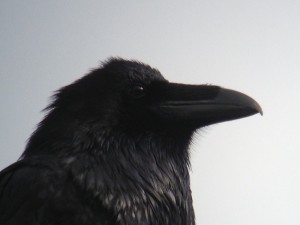 In October 2011, in late afternoon on a clear fall day, a large congregation of Common Ravens was observed along Route 30 in the central Adirondack Town of Long Lake, New York near the intersection with Sabattis Circle Road. Well over one hundred ravens perched up in trees lining the highway in an area that contains both boreal and mixed forest habitats. The ravens were extremely vocal, loudly giving their seemingly endless array of calls. From the vantage point of my car-blind parked at the intersection, and with windows down, observations continued for over two hours.
In October 2011, in late afternoon on a clear fall day, a large congregation of Common Ravens was observed along Route 30 in the central Adirondack Town of Long Lake, New York near the intersection with Sabattis Circle Road. Well over one hundred ravens perched up in trees lining the highway in an area that contains both boreal and mixed forest habitats. The ravens were extremely vocal, loudly giving their seemingly endless array of calls. From the vantage point of my car-blind parked at the intersection, and with windows down, observations continued for over two hours.
The Common Ravens deafening chorus of calls continued. After about ten minutes, Eastern Coyotes began to howl from a long distance away in the forest across the highway from my vehicle. Two ravens, loudly vocalizing, flew in the direction of the coyotes. They flew back and forth between the large gathering of ravens and the direction of the howling coyotes. The howling ceased and the ravens continued to loudly vocalize with the pair of ravens continuing their flights toward the coyotes and then back again toward the other ravens. About a half hour later, crunching leaves were heard as unseen animals paced back and forth just behind the trees up on the bank along the highway directly across from my vehicle. The ravens continued to vocalize. As it began to grow dark, a coyote appeared at the top of the bank and headed down to a fresh road-killed deer in the ditch. All of the ravens instantly ceased vocalizing in perfect unison. They stared down at the coyote heading for the deer and remained perfectly still. The coyote began to rip at the deer with its mouth. After a while, a second, much lighter-colored coyote appeared at the top of the bank and tentatively headed for the deer. It was fearful of the passing vehicles, and would run back into the forest every time one passed by. The other coyote appeared unafraid of the traffic. But during a long lull in passing vehicles, it became apparent that the lighter-colored coyote was dominant and a vicious fight ensued with the darker-colored coyote quickly backing off. Each time a vehicle passed, the lighter-colored coyote would run into the forest and the darker-colored coyote would try to feed while the dominant coyote was gone. The darker coyote would immediately back away from the deer carcass when the lighter coyote came back down the bank. The ravens continued to remain absolutely silent and still on their perches as they stared down at the deer carcass and coyotes. They did not attempt to fly down to the carcass as the coyotes began to rip it open.
As it grew quite dark, groups of ravens began to head to a roost somewhere south of the highway. Just as it appeared they had all flown away, two ravens made a circle over the deer carcass in almost total darkness before flying off. It had now grown too dark to observe the coyotes at the deer carcass, so observations ended when the last two ravens flew to their roost.
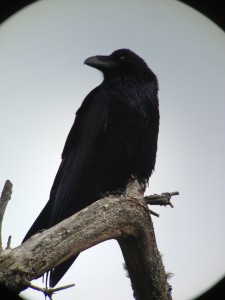 Interpreting animal behavior and communication can often be challenging. Common Ravens need scavengers, like coyotes, to rip open the skin of large mammals before they can feed. If a raven can alert a coyote to potential live prey or carrion, both species benefit. Common Ravens feeding on other predators’ kills is well documented, but ravens leading predators, such as coyotes, wolves, bears, or cougars, to potential live prey or carrion, by using vocalizations, is not as well documented.
Interpreting animal behavior and communication can often be challenging. Common Ravens need scavengers, like coyotes, to rip open the skin of large mammals before they can feed. If a raven can alert a coyote to potential live prey or carrion, both species benefit. Common Ravens feeding on other predators’ kills is well documented, but ravens leading predators, such as coyotes, wolves, bears, or cougars, to potential live prey or carrion, by using vocalizations, is not as well documented.
Bernd Heinrich offers possible evidence in his book Mind of the Raven, which suggests ravens lead predators to potential food. In a couple of the news stories he recounts, humans credited ravens’ vocalizations with saving their lives – one from a cougar and one from a bear. Heinrich has just the opposite interpretation and believes that the ravens were alerting these predators to potential prey, and as a result, both species would benefit with food. It is a much more likely explanation than ravens benevolently vocalizing to save a human from a potential predator!
The October 2011 observations appeared to be Common Ravens leading Eastern Coyotes to carrion through vocalizations. It is a mutually beneficial relationship when predators pay attention to raven (or crow) vocalizations that lead to potential food for both species. Ravens cannot kill large prey nor open the skin of large carrion (such as intact road-killed deer). But they can easily spot potential live prey and carrion from the air. By ravens utilizing vocalizations to communicate, and lead, land-based predators to live prey or carrion that the ravens have observed from above, benefits both species with food. This apparent symbiotic relationship between Common Ravens (along with other corvids such as American Crows) and predators merits further study.
A Couple of Other Brief Related Observations
Over a decade ago, loud American Crow vocalizations were heard outside our home in Long Lake, New York in the central Adirondack Mountains. From the vantage point of our front porch, two American Crows were observed. One was perched over an out-building, and another in a tree across the lawn. Between the crows, an Eastern Coyote was slowly making its way toward the crow over the out-building. At the time, a feral cat had taken up residence in this building. The coyote eventually spotted me and ran off. It appeared that the crows were luring the coyote toward the building with the feral cat. It is difficult to clearly interpret this type of behavior, but there appeared to be communication going on between the American Crows and the Eastern Coyote that morning.
During a decade hiking with two Golden Retrievers, it quickly became apparent that there is an innate relationship among corvids and canines. Common Ravens were encountered on nearly every hike and the ravens appeared to be attracted to the dogs, and the dogs nearly always responded to raven vocalizations by looking up. It was a relationship that could not be missed over the course of a decade!
A Night Out in the Adirondack Wilderness
On Friday, October 11, 2013, my husband George and I camped at the “Island House” lean-to along the remote, north-end of 14-mile Long Lake (this lean-to has views across the lake of an island of the same name). We motored over 8 miles from our beach to this spectacular location about ¾ of a mile from the north end of the lake. This end of Long Lake is surrounded by Adirondack wilderness, with mostly boat-access-only camps, and lovely views of the High Peaks. In spring and fall, you can often have this end of the lake completely to yourself. It feels like paradise!
As we slowly motored north in our pontoon boat, a young Bald Eagle was also heading north and it flew parallel to our boat over the shoreline. Common Loons were numerous and molting into their duller winter plumage. Female Common Mergansers were diving for food. We passed Round Island, Camp Islands, Pancake Islands, and Island House before pulling up to our camp location. The lean-to was hidden up on a knoll of mature White Pine, Hemlock, and Birch trees.
As we pulled up to the shoreline, I noticed an Osprey perched about 75 feet away on a dead snag over the water. It was drenched from fishing. The bird took flight and actively fished for several minutes, dragging its feet and body across the lake in continuous, futile dive attempts to catch fish.
The sun was beginning to set, so we quickly set up the lean-to with our camping gear. As the light faded away, a Bald Eagle began to vocalize on the island across from our camp. This is the same island where Bald Eagles now nest each year. I found it interesting that they were still roosting at the nest location in October. Nearly dark now, a shorebird silhouette quickly flew along the shoreline.
George built a fire. The sky was clear and it was going to be a cold night.
Memories…
**********
I began to think about all the places I’ve camped around Long Lake in over a decade and a half. This location was the 12th different place, with well over 40 different camping trips across all four seasons. Some of the trips were at lean-to locations or designated tent areas, but many were bushwhack trips to wetlands or mountain summits along the lake. Many of the trips were with our two sons and their friends as they grew up. There were many humorous moments…
One time we camped in a lean-to location and found a large group of Girl Scouts in a nearby lean-to that sang non-stop until 1 a.m.!
Another time, I took my two sons and two Golden Retrievers to a lean-to location where a couple thru-hiking the 136-mile Northville-Placid Trail (which runs along Long Lake) showed up and used their tent so we could have the lean-to. Just as we were all heading to bed, the young man said, “Hey, one of my boots is missing”! Anyone who has spent time with Golden Retrievers knows exactly what happened! We all searched for hours with headlamps, and I finally offered to boat to town in the morning and buy the man a new pair of hiking boots (he still had 36 miles of wilderness to hike through). I imagined that my dog Max had dumped his boot in the lake! But by some miracle, Max got up at 3 a.m. and ran off into the woods, and returned with the missing boot! Phew!
On a solo camp trip to the very north end of the lake at Turtle Beach, I arrived at sunset to find a family of 3 (plus their son’s friend) with 3 large tents (one for the parents, one for the boys, and one for their toys…lots of toys!), furniture (tables, chairs, etc.), and enough lamps and lights that the place was lit up like a church. I stood speechless wondering how they fit it all in their boat. It felt as if they had brought suburbia to the wilderness! The next morning, as the family slept, I had coffee while watching an actively hunting Mink at the edge of the water!
During one of my difficult trips bushwhacking up Kempshall Mountain for the annual June Mountain Birdwatch survey, I found an older man and his son setting up a bivouac camp because they had been lost all day finding the summit and ran out of light to get down. They broke branches all night to keep a fire going, so I didn’t really sleep. I got up at 4 a.m. and began the survey at 4:30. I am sure they wondered what on Earth this woman was doing in the middle of nowhere counting birds at dawn! After the survey, I offered to lead them back to their campsite on the lake. They fell several times on the descent (1800’ of elevation over 2 miles) and I noticed one was in sandals and one in sneakers!
Another time, I bushwhacked to a wetland for the NYS Breeding Bird Atlas work. Something began to charge my tent in the dark, which I immediately imagined to be a Black Bear. I was thrilled to find an aggressive Ruffed Grouse in the light of my headlamp instead!
One winter, I camped without a tent near another wetland on top of several feet of snow, and 3 different coyote packs howled around me from the forest – all I could think about was whether they might accidently step on me in the night!
During a summer trip in August, with my sons, and a friend and her teenage daughter, we camped at Plumley’s lean-to. I forgot about insects at that time of year and the mosquitoes were horrendous! The teenage girl declared in a terse statement that she would sit up all night by the fire rather than deal with the bugs attacking her head in the sleeping bag!
Some trips turned into interesting learning experiences. On a bushwhack up Rock Pond Mountain (also for Atlas work), I first realized that jet plane noise really bothers birds during the night. I was awakened all night by vocalizing Common Loons, and songbirds actively moving and making small sounds in the dark – and a few seconds later, I would hear a jet plane go over. The birds were able to hear the jet a few seconds before my ears could pick it up. I’ve since noticed this correlation on other camping trips. I suspect that the huge 4th of July fireworks display over Long Lake each year is frightening to the birds, and no doubt to other wildlife too.
**********
Anyway, our current camp trip was in perfectly calm winds, clear skies, chilly temps, with a waxing moon in the sky. During the night, I heard two Barred Owls vocalizing. Barred Owls, like Common Ravens, seem to have an endless array of vocalizations, and I had never heard this particular sound from them. In my sleep haze, I memorized a mnemonic so I could recall it for my friend Sean O’Brien who does recordings for the Cornell Lab of Ornithology. Of course, I couldn’t remember it in the morning! My husband said he also awakened to the owls. Throughout the night, we heard the haunting calls of Common Loons piercing the world.
George and I got up at 4:30 a.m. (our normal wake-up time) with over two hours of darkness before dawn! A Fox gave its scary scream across the lake. The stars were spectacular and mirrored in the smooth surface of Long Lake. Orion and the Big Dipper were visible. A couple different meteors streaked across the sky. I spent over 2 hours captivated at the edge of the lake with completely numb feet. I live for these moments. “Dawn is a feeling” kept going through my head as I watched all the fascinating changes as the Earth rotated east toward “day”. I could hear a few migrant voices flying over in the dark. By 6:15 a.m., migrant Hermit Thrushes and a few sparrows began their descent – this continued until about 6:25 a.m. Long before dawn, the Bald Eagle began to vocalize again on its island roost. A coyote pack howled somewhere at the north end of the lake. Two Barred Owls called across the lake, and a third started up across the lake behind the eagle island. Barred Owl vocalizations seem so much louder along the lake. Song Sparrows sang at dawn. Pileated Woodpeckers called. A Belted Kingfisher rattled. A migrant Greater Yellowlegs called. Migrant Ruby-crowned Kinglets filled the bushes. Hardy Yellow-rumped Warblers were numerous. Over 30 species were found between dusk and dawn on this trip.
I photographed the north end of the lake and the eagle island as my eyes began to detect light. I wanted to see what time my eyes would go from “gray” to sensing “color” (rods to cones) – it was 6:40 a.m.!
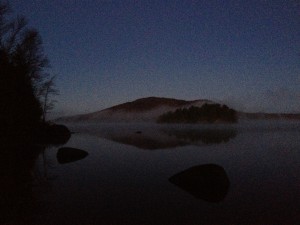
One: Looking out at the island with nesting eagles at dawn from Island House lean-to on Long Lake. Taken on October 12, 2013.
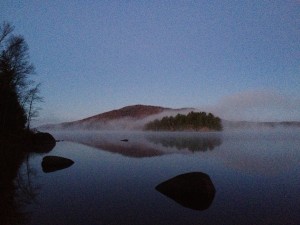
Two: Looking out at the island with nesting eagles at dawn from Island House lean-to on Long Lake. Taken on October 12, 2013.
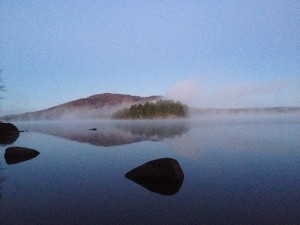
Three: Looking out at the island with nesting eagles at dawn from Island House lean-to on Long Lake. Taken on October 12, 2013.
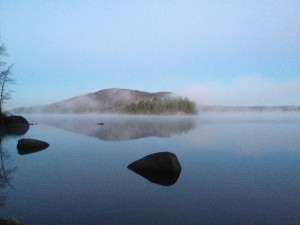
Four: Looking out at the island with nesting eagles at dawn from Island House lean-to on Long Lake. Taken on October 12, 2013.
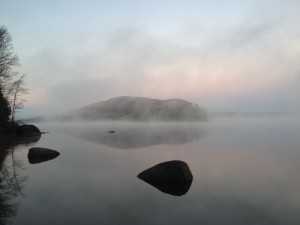
Five: Looking out at the island with nesting eagles at dawn from Island House lean-to on Long Lake. Taken on October 12, 2013.
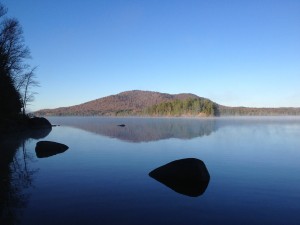
Six: Looking out at the island with nesting eagles at dawn from Island House lean-to on Long Lake. Taken on October 12, 2013.
I spotted an adult Bald Eagle perched in a dead snag on the island. I got my scope to photograph it with my iPhone attachment, but a large bank of fog rolled in and obscured the bird. Later, as we began to break down our camp, we observed two other Bald Eagles flipping and latching talons over the lake! About 10 minutes after hearing several gun shots at the north end of Long Lake (duck hunting season), I spotted a white-headed, white-tailed bird in the water with my scope. It was in the fog about ¾ of a mile away. It quickly became apparent it was an adult Bald Eagle struggling in the water. I observed it for about 15 minutes using its wings as paddles to reach the shoreline. I was sick wondering if a hunter had shot it. Even on the shore, the bird was unable to take off. I called my husband to come to the lake, and we decided to take the boat to the bird to see if it was hurt. While we discussed this, I noticed the eagle was eating – it no doubt had a very heavy fish (out of our view in all the fog) that made it impossible for the eagle to take flight! I wish I could have seen that fish!
One of the many documented effects of climate change in our area is the ice-on and ice-off dates. Historically, October was a cold month, and major snowstorms were common. Now, falls are warm, and the ice-on date has moved out nearly two months to December. Common Loons stay two months longer now, and sea planes and boats remain on the lakes into December. Snow often does not arrive to stay until January. The spring ice-off date has moved back about a month. These are rapid, unprecedented changes with frightening impacts on both flora and fauna. I reminded my husband that back in the late 1990s, October 11th would have been cold and possibly snowy. But the October of a rapidly warming world in 2013, was in the 60s on the 11th and went up to the 70s on the 12th as we boated home. “Normal” no longer seems to apply because the climate just keeps changing year to year. Tourists and summer residents still focus on July and August for visiting. Those of us fortunate enough to live here year-round have gained several months of quiet boating time on the lakes. I would gladly trade this benefit of climate change if I could turn back the clock on atmospheric CO2 to pre-industrial revolution levels…
September 2013 Tours and a few other Sightings
***For photos taken in September 2013, see the photographic blog post, “September 2013 Photographs”.***
September 1, 2013
On a drive of Sabattis Circle Road in Long Lake (26 species):
Wild Turkey with young
Great Blue Heron
Broad-winged Hawk
American Kestrel
Belted Kingfisher
Black-backed Woodpecker – male & female
Blue-headed Vireo
Red-eyed Vireo
Blue Jay
Black-capped Chickadee
Red-breasted Nuthatch
Brown Creeper – singing
Winter Wren
Golden-crowned Kinglet
Cedar Waxwing
Nashville Warbler
Magnolia Warbler
Black-throated Blue Warbler – singing
Yellow-rumped Warbler
Black-throated Green Warbler
Black-and-white Warbler – singing
Common Yellowthroat
Chipping Sparrow
Song Sparrow – no tail juvenile
White-throated Sparrow
American Goldfinch
***********************
September 2, 2013
A few species at dawn outside our Long Lake home:
Common Loon – calls echoing up our mountain (The Pinnacle) from the lake
Pileated Woodpecker
Winter Wren – singing (juvenile observed)
Swainson’s Thrush – several migrants
Hermit Thrush – calling
Ovenbird
Other wildlife – a male deer, two females, and a fawn are regulars each day, also a flock of 17 Wild Turkeys (often they are all together), and an Eastern Coyote has been hunting along the edge of our lawn.
***********************
September 3, 2013
Hanging Spear Falls Trail (High Peaks area)
This was an afternoon berry picking trip, but I still noted a few species:
Swainson’s Thrush
Hermit Thrush
Scarlet Tanager
The suspension bridge over the Hudson River is still out 2.5 years after it washed out in the floods of April 2011. I had to wade across. Also, the boardwalk over Lake Jimmy washed out this year in flooding, so the trail has been re-routed around the lake (to the north).
***********************
September 4, 2013
Whiteface Mountain summit at dawn (high winds), Bloomingdale area, and Tupper Lake Causeway (44 species):
Canada Goose
Wood Duck
Amer. Black Duck
Mallard
Ring-necked Duck
Wild Turkey
Great Blue Heron
Turkey Vulture
Osprey
Amer. Kestrel – 2
Ring-billed Gull
Mourning Dove
Belted Kingfisher
Hairy Woodpecker
Northern Flicker
Pileated Woodpecker
Eastern Phoebe
Red-eyed Vireo
Blue Jay
Amer. Crow
Common Raven
Black-capped Chickadee
Boreal Chickadee – 8
Red-breasted Nuthatch
Winter Wren – singing
Golden-crowned Kinglet
Eastern Bluebird
Bicknell’s Thrush – 15 to 20 birds calling (one song)
Amer. Robin
European Starling
Cedar Waxwing
Nashville Warbler
Chestnut-sided Warbler
Cape May Warbler
Yellow-rumped Warbler
Black-throated Green Warbler
Blackpoll Warbler – singing
Black-and-white Warbler
Common Yellowthroat
Chipping Sparrow
Song Sparrow
White-throated Sparrow
Dark-eyed Junco
Amer. Goldfinch
***********************
September 6, 2013
On a tour with a birder from North Carolina, we visited Sabattis Circle Road (including Sabattis Bog), Tupper Lake Marsh, Lake Durant, Moose River Plains, and Raquette Lake. Here are the 46 species found:
Wood Duck
American Black Duck
Ring-necked Duck
Wild Turkey
Common Loon – an adult on Lake Durant, and an adult with a chick on Raquette Lake
Great Blue Heron – many
Osprey
Sharp-shinned Hawk – 4
Cooper’s Hawk – 2
Broad-winged Hawk
Red-tailed Hawk
Belted Kingfisher – several
Yellow-bellied Sapsucker – 1 adult and 1 juvenile
Hairy Woodpecker
Northern Flicker – many
Pileated Woodpecker
Eastern Phoebe
Blue-headed Vireo
Red-eyed Vireo
Gray Jay – heard
Blue Jay
American Crow
Common Raven
Black-capped Chickadee
Boreal Chickadee – Helldiver Pond
Red-breasted Nuthatch
Winter Wren
Golden-crowned Kinglet
Ruby-crowned Kinglet
Hermit Thrush
American Robin
Gray Catbird
Cedar Waxwing
Chestnut-sided Warbler
Magnolia Warbler
Black-throated Blue Warbler
Yellow-rumped Warbler
Black-throated Green Warbler
Blackburnian Warbler
Common Yellowthroat
Song Sparrow
Swamp Sparrow
White-throated Sparrow
Dark-eyed Junco
Common Grackle
American Goldfinch
***********************
September 7, 2013
On a tour with a couple from Virginia, we visited Whiteface Mountain at dawn, and lowland mixed and boreal habitat areas. Here are the 42 species found:
Double-crested Cormorant – on Lake Flower
Turkey Vulture
American Kestrel – male
Ring-billed Gull
Rock Pigeon
Mourning Dove
Belted Kingfisher
Downy Woodpecker
Hairy Woodpecker
Northern Flicker
Pileated Woodpecker
Blue-headed Vireo
Red-eyed Vireo
Gray Jay – 12! (Groups of 4, 3, and 5); including one Gray Jay with a mushroom cap in its bill!
Blue Jay
American Crow
Common Raven
Black-capped Chickadee – still feeding young!
Boreal Chickadee – 8! (Groups of 5, 2, and 1)
Red-breasted Nuthatch
Brown Creeper
Winter Wren – singing
Golden-crowned Kinglet
Ruby-crowned Kinglet
Bicknell’s Thrush – 15 calling birds!; one partial song at dawn
American Robin
Gray Catbird
Cedar Waxwing – feeding young!
Nashville Warbler
Chestnut-sided Warbler
Magnolia Warbler
Black-throated Blue Warbler
Yellow-rumped Warbler
Black-throated Green Warbler
Common Yellowthroat
Song Sparrow
Swamp Sparrow
White-throated Sparrow
Dark-eyed Junco
Rose-breasted Grosbeak
American Goldfinch
We also found large Moose tracks!
***********************
September 9, 2013
On a hike at Massawepie Mire with David Buckley, we found the following 45 species:
Canada Goose – a few flocks overhead
Wood Duck
Common Loon
Turkey Vulture
Bald Eagle
Broad-winged Hawk
Amer. Kestrel
Merlin
Black-billed Cuckoo – great views! It was giving its amphibian-sounding call (heard also on migration)
Yellow-bellied Sapsucker
Hairy Woodpecker
Black-backed Woodpecker – male
Northern Flicker
Pileated Woodpecker
Blue-headed Vireo
Red-eyed Vireo
Gray Jay – 7 (groups of 2 and 5)
Blue Jay
Common Raven
Black-capped Chickadee
Boreal Chickadee – 7 (groups of 3 and 4)
Red-breasted Nuthatch
Winter Wren – singing
Golden-crowned Kinglet – singing
Veery – several migrants foraging among Amer. Robins (lots of skirmishes between these 2 species), Cedar Waxwings, and White-throated Sparrows
Swainson’s Thrush – 1
Hermit Thrush – several
American Robin
Cedar Waxwing
Northern Parula – singing
Magnolia Warbler – several
Cape May Warbler – 3 observed
Yellow-rumped Warbler – abundant
Blackburnian Warbler – 1
Pine Warbler – 1
Palm Warbler – abundant
Common Yellowthroat – several; some singing
Wilson’s Warbler – 1
Scarlet Tanager – 1
Song Sparrow
Lincoln’s Sparrow – several observed, and one sang once!
White-throated Sparrow – abundant
Dark-eyed Junco
Purple Finch
American Goldfinch
We also observed a Bobcat at 10:30 a.m.!
***********************
September 13, 2013
A few species outside our Long Lake house at dawn:
Ruby-throated Hummingbird
Northern Flicker
Blue-headed Vireo
Red-eyed Vireo
Winter Wren
Amer. Robin
Black-throated Green Warbler
Blackburnian Warbler
Blackpoll Warbler
Black-and-white Warbler
Scarlet Tanager
***********************
September 14, 2013
On a drive along Sabattis Circle Road:
Great Blue Heron
Ruby-throated Hummingbird
Northern Flicker
Gray Jay – two different places
Brown Creeper
Winter Wren
Golden-crowned Kinglet
Cedar Waxwing
Northern Parula
Magnolia Warbler
Black-throated Blue Warbler
Yellow-rumped Warbler
Black-throated Green Warbler – feeding young in a family group
Palm Warbler
Black-and-white Warbler
Ovenbird
Song Sparrow
Swamp Sparrow
White-throated Sparrow
***********************
September 15, 2013
At the Tupper Lake causeway with Pat & John Thaxton, after our Northern NY Audubon board meeting, we observed a western (brown) Palm Warbler migrant, and a Common Yellowthroat.
***********************
September 17, 2013
Some of the species along Powley Place Rd. in southern Hamilton Co.:
Ruffed Grouse – drumming
Yellow-bellied Sapsucker
Hairy Woodpecker
Northern Flicker
Blue-headed Vireo
Philadelphia Vireo
Hermit Thrush
Black-throated Blue Warbler
Yellow-rumped Warbler
Palm Warbler – western (brown) migrant
Common Yellowthroat
Chipping Sparrow
Lincoln’s Sparrow
White-throated Sparrow
***********************
September 18, 2013
Outside our Long Lake house, Swainson’s Thrush migrants continue to be observed. A juvenile, female Ruby-throated Hummingbird continues at our feeders (see below…9/8 is the typical late date for our home).
***********************
September 23, 2013
This was the last day I observed the juvenile, female Ruby-throated Hummingbird at our Long Lake feeders! I was able to take photos of the bird that day. This is a record late date for our location, and it came close to the late date for our county. (I returned from a trip to Iowa on 8/26/13 and all the males were already gone.)
***********************
September 24, 2013
Thirty-three species from outside our Long Lake house and along Sabattis Circle Road:
Canada Goose
Wood Duck
Wild Turkey
Bald Eagle
Amer. Kestrel
Yellow-bellied Sapsucker
Black-backed Woodpecker
Northern Flicker
Blue-headed Vireo
Red-eyed Vireo – feeding young
Gray Jay – 6 (groups of 3 and 3)
Blue Jay
Common Raven
Black-capped Chickadee
Red-breasted Nuthatch
Brown Creeper
Winter Wren
Golden-crowned Kinglet
Swainson’s Thrush
Hermit Thrush
Amer. Robin
Nashville Warbler
Northern Parula
Black-throated Blue Warbler
Yellow-rumped Warbler
Black-throated Green Warbler
Blackburnian Warbler
Blackpoll Warbler
Song Sparrow
White-throated Sparrow
**White-crowned Sparrow – first of the season
Rusty Blackbird – vocalizing near Sabattis Bog
Amer. Goldfinch
***********************
September 25, 2013
Out at 1 a.m. listening to migrants overhead; outside our house at dawn; along the Northville-Placid Trail (S) in Long Lake; and back outside at 9:30 p.m. for more migrants!
At 1 a.m. – many Common Loon vocalizations echoing up from the lake, two Barred Owls vocalizing back and forth, lots of migrant birds flowing overhead including Swainson’s Thrushes, two coyote packs howling, and the spectacular stars (with the Milky Way band evident) and moon!
At dawn – Blue-headed Vireo, Brown Creeper (singing), Winter Wren, Swainson’s Thrush, Hermit Thrush, American Robin (eating the Hawthorn tree berries), Black-throated Blue Warbler, Yellow-rumped Warbler, and Blackpoll Warbler.
Along the N-P Trail – Boreal Chickadee and Winter Wren
Back out at 9:30 p.m. – Common Loons and two Barred Owls vocalizing again, plus migrants overhead.
***********************
September 26, 2013
Forty-five species found at the Tupper Lake Causeway and Massawepie Mire:
Canada Goose
Wood Duck
Amer. Black Duck
Mallard
Ring-necked Duck
Ruffed Grouse – 2
Common Loon
Great Blue Heron
Turkey Vulture
Red-tailed Hawk
Amer. Kestrel
Rock Pigeon
Mourning Dove
Belted Kingfisher
Hairy Woodpecker
Black-backed Woodpecker
Northern Flicker
Pileated Woodpecker
Blue-headed Vireo – singing
Gray Jay – 4 (groups of 2 and 2)
Blue Jay
Amer. Crow
Common Raven
Black-capped Chickadee
Boreal Chickadee – at least 4
Red-breasted Nuthatch
Brown Creeper – singing
House Wren! (This is the 3rd time I’ve found this species at Massawepie over the years.)
Winter Wren
Golden-crowned Kinglet
Ruby-crowned Kinglet
Eastern Bluebird (Tupper Lake)
Hermit Thrush
Amer. Robin
Cedar Waxwing
Yellow-rumped Warbler – many
Palm Warbler – many
Common Yellowthroat
Song Sparrow
Swamp Sparrow – several
White-throated Sparrow
White-crowned Sparrow
Dark-eyed Junco
Purple Finch
Amer. Goldfinch
***********************
September 28, 2013
Thirty-four species were found at the Tupper Lake Causeway, Mountaineer Trail (at Massawepie), Viewing Deck at Massawepie, and Deer Pond at Massawepie:
Canada Goose
Wood Duck
Amer. Black Duck
Mallard
Ring-necked Duck
Ruffed Grouse – 2 (one was drumming)
Common Loon – Long Lake and Deer Pond
Great Blue Heron
Ring-billed Gull
Rock Pigeon
Mourning Dove
Northern Flicker
Pileated Woodpecker – 5 along the Mountaineer Trail – calling and drumming
Gray Jay – 2
Blue Jay
Amer. Crow
Common Raven
Black-capped Chickadee
Red-breasted Nuthatch
Brown Creeper – singing
Winter Wren
Golden-crowned Kinglet
Ruby-crowned Kinglet
Hermit Thrush
Amer. Robin
European Starling
Cedar Waxwing
Yellow-rumped Warbler
Pine Warbler – singing
Common Yellowthroat
Swamp Sparrow
White-throated Sparrow
Dark-eyed Junco
Amer. Goldfinch
***********************
September 29, 2013
My husband George and I took our pontoon boat to Kempshall Landing along Long Lake. We bushwhacked up the north side of Blueberry Mountain and came down the south side cliffs. We followed a remnant tote road between Blueberry Mountain and Landing Hill back to the Northville-Placid Trail. There are many active beaver locations along the tote road. We followed the N-P Trail back to our boat by sunset. I counted TWENTY-ONE Common Loons to our north at Camp Islands!!! This is the largest gathering I’ve observed on Long Lake.
***********************
September 30, 2013
Outside our Long Lake house at dawn, a Blue-headed Vireo and Brown Creeper sang.
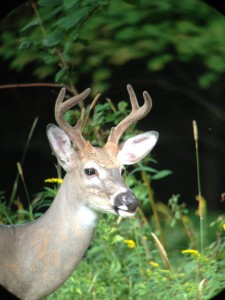
Male White-tailed Deer transitioning from its summer-red coat to the winter-gray coat. Taken outside our Long Lake house on 9/2/13.
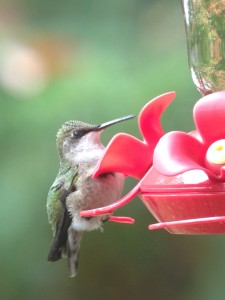
Female, juvenile Ruby-throated Hummingbird that visited our Long Lake feeders until September 23, 2013 – very late for this species.
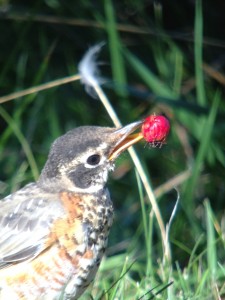
American Robin eating a Hawthorn berry outside our Long Lake home on September 25, 2013. Hoards of robins descend on this tree each fall!
More images of the Adirondack boreal…
Here is another photographic blog with miscellaneous photographs taken during August 2013, mostly in boreal habitat:
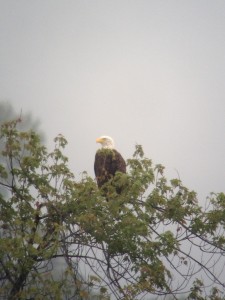
Adult Bald Eagle perched over Tupper Lake just after a non-stop attack on a Great Blue Heron. Taken on August 15, 2013.
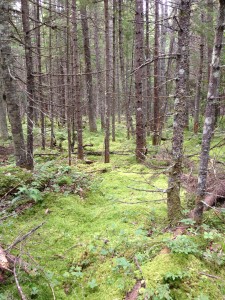
Lovely boreal forest along the Northville-Placid Trail in Long Lake. Photographed on August 18, 2013.
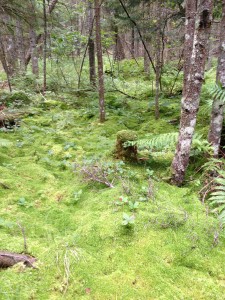
Sphagnum Moss in the boreal forest along the Northville-Placid Trail in Long Lake. Photograph taken on August 18, 2013.
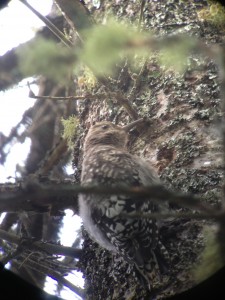
Juvenile Yellow-bellied Sapsucker blending in along the Northville-Placid Trail in Long Lake. Photograph taken on August 18, 2013.
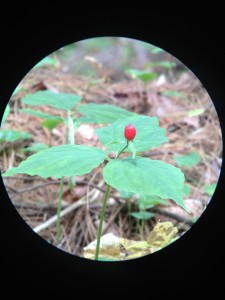
A trillium gone to berry along the Northville-Placid Trail in Long Lake. Photograph taken on August 18, 2013.
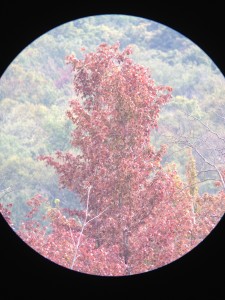
Leaves begin to change color in early August in the Adirondacks. Photograph taken on August 18, 2013 at the north end of Long Lake.
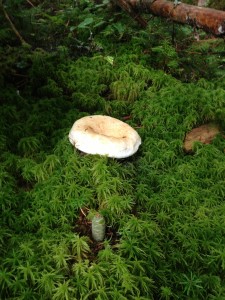
Large mushroom growing in the sphagnum moss along the Northville-Placid Trail in Long Lake. Photograph taken on August 27, 2013.
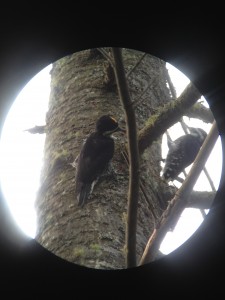
A juvenile male Black-backed Woodpecker (left) begging from an adult male Black-backed Woodpecker (right) along the Northville-Placid Trail in Long Lake. Photograph taken on August 27, 2013.
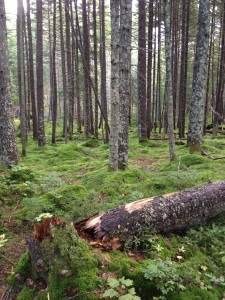
Lovely boreal forest near Helldiver Pond in Moose River Plains. Photograph taken on August 29, 2013.
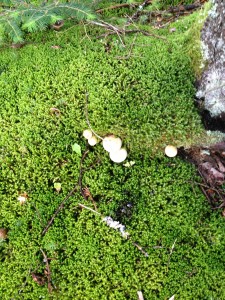
Mushrooms growing from sphagnum moss in the boreal forest near Helldiver Pond in Moose River Plains. Photograph taken on August 29, 2013.
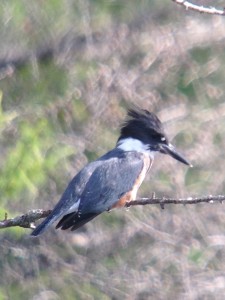
Belted Kingfisher hunting over Helldiver Pond in Moose River Plains. Photograph taken on August 29, 2013 from way across the pond!
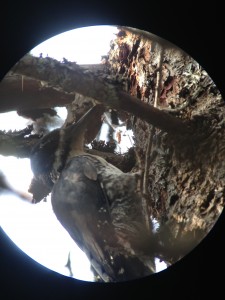
Female Black-backed Woodpecker at Moose River Plains (between Helldiver Pond and Lost Ponds Trails). Photograph taken on August 29, 2013.
Wildflowers of August
Here are some wildflower photographs taken in August 2013, mostly in the boreal forest:
August mushrooms of the boreal forest
With a record wet late spring – early summer in the Adirondacks, it is turning out to be an excellent season for mushrooms! I have included photographs taken during August 2013 outings in the boreal forest below:
This blog post provides a list of species from tours during July 2013. I have also included a few photos.
On a July 5, 2013 tour with a couple from New Jersey, we visited two low-elevation boreal bogs and a marsh. We found the following 66 species (including 16 warbler species with many lovely views):
Wild Turkey
Common Loon – 2 adults and 2 chicks!
Turkey Vulture
Broad-winged Hawk
Merlin
Wilson’s Snipe
Rock Pigeon
Mourning Dove
Barred Owl
Yellow-bellied Sapsucker
Hairy Woodpecker
Black-backed Woodpecker – family group! (Male, female, and at least one juvenile)
Northern Flicker
Yellow-bellied Flycatcher
Alder Flycatcher
Least Flycatcher
Eastern Phoebe
Blue-headed Vireo
Red-eyed Vireo
Gray Jay – 2!
Blue Jay
American Crow
Common Raven
Tree Swallow
Barn Swallow
Black-capped Chickadee
Red-breasted Nuthatch
Brown Creeper
Winter Wren
Golden-crowned Kinglet
Eastern Bluebird
Veery
Swainson’s Thrush
Hermit Thrush
American Robin
Gray Catbird
European Starling
Cedar Waxwing
Nashville Warbler
Northern Parula
Yellow Warbler
Chestnut-sided Warbler
Magnolia Warbler
Black-throated Blue Warbler
Yellow-rumped Warbler
Black-throated Green Warbler
Blackburnian Warbler
Pine Warbler
Palm Warbler
American Redstart
Ovenbird
Mourning Warbler
Common Yellowthroat
Canada Warbler
Scarlet Tanager
Chipping Sparrow
Song Sparrow
Lincoln’s Sparrow – nice views!
Swamp Sparrow
White-throated Sparrow
Dark-eyed Junco
Rose-breasted Grosbeak
Indigo Bunting – nice views!
Red-winged Blackbird
Purple Finch
American Goldfinch
We also found a Coyote and a small Snapping Turtle!
*******On a June 11, 2013 tour with a birder from Connecticut, we visited both high and (briefly) low elevation boreal habitat. We found the following 44 species:
Turkey Vulture
Broad-winged Hawk
Mourning Dove
Black-backed Woodpecker – female
Yellow-bellied Flycatcher
Least Flycatcher
Blue-headed Vireo
Red-eyed Vireo
Blue Jay
American Crow
Common Raven
Tree Swallow
Barn Swallow
Black-capped Chickadee
Boreal Chickadee
Red-breasted Nuthatch
House Wren
Winter Wren
Golden-crowned Kinglet
Ruby-crowned Kinglet
Eastern Bluebird
Bicknell’s Thrush – nice views!
Swainson’s Thrush
Hermit Thrush
American Robin
Cedar Waxwing
Nashville Warbler
Northern Parula
Chestnut-sided Warbler
Magnolia Warbler
Black-throated Blue Warbler
Yellow-rumped Warbler
Black-throated Green Warbler
Blackburnian Warbler
Blackpoll Warbler
Black-and-white Warbler
American Redstart
Ovenbird
Mourning Warbler – nice views!
Chipping Sparrow
White-throated Sparrow
Dark-eyed Junco
Indigo Bunting
Purple Finch
We also observed a young Black Bear!
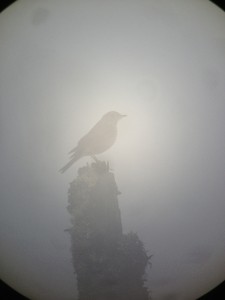
Bicknell’s Thrush in the fog photographed on July 11, 2013 during a Dawn Tour up Whiteface Mountain.
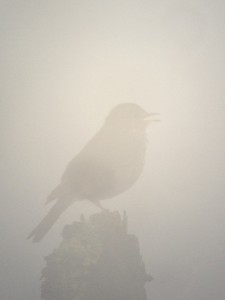
Bicknell’s Thrush singing in the fog – photographed on July 11, 2013 during a Dawn Tour up Whiteface Mountain
On a July 14, 2013 tour with a birder from Ithaca and a birder from Rochester, we visited both high and low elevation boreal habitat. We found the following 45 species:
American Kestrel
Rock Pigeon
Mourning Dove
Yellow-bellied Flycatcher
Eastern Phoebe
Blue-headed Vireo
Red-eyed Vireo
Blue Jay
American Crow
Common Raven
Tree Swallow
Barn Swallow
Black-capped Chickadee
Red-breasted Nuthatch
Winter Wren
Golden-crowned Kinglet
Ruby-crowned Kinglet
Bicknell’s Thrush – nice views of a singing bird (a couple attached)
Swainson’s Thrush
Hermit Thrush
American Robin
Cedar Waxwing
Nashville Warbler
Northern Parula
Chestnut-sided Warbler
Magnolia Warbler
Black-throated Blue Warbler
Yellow-rumped Warbler
Black-throated Green Warbler
Blackburnian Warbler
Blackpoll Warbler – feeding young!
Ovenbird
Mourning Warbler – calling
Common Yellowthroat
Chipping Sparrow
Savannah Sparrow
Song Sparrow
Lincoln’s Sparrow – nice views!
Swamp Sparrow
White-throated Sparrow
Dark-eyed Junco
Indigo Bunting – nice views!
Bobolink – female
Purple Finch
American Goldfinch
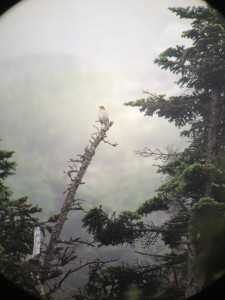
Bicknell’s Thrush photographed during a Dawn Tour up Whiteface Mountain on July 14, 2013. It is reminiscent of a Hudson River School painting scene!
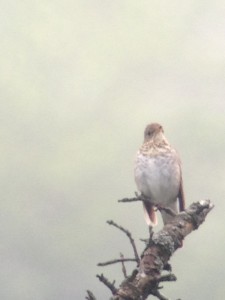
A zoomed in photograph of the same bird – photographed on a Dawn Tour up Whiteface Mountain on July 14, 2013.
On a July 21, 2013 tour with a couple from Elmira, NY, we visited a low-elevation boreal bog and early the next morning, we visited a boreal forest. We found the following 70 species (including 17 warbler species with many nice views):
Canada Goose
Wood Duck – family
Common Loon – 2 adults and 2 young!
Turkey Vulture
Northern Harrier
Broad-winged Hawk
Merlin
Rock Pigeon
Mourning Dove
Ruby-throated Hummingbird
Belted Kingfisher
Yellow-bellied Sapsucker
Hairy Woodpecker
Northern Flicker
Alder Flycatcher
Least Flycatcher
Eastern Phoebe
Eastern Kingbird
Blue-headed Vireo
Red-eyed Vireo
Gray Jay – 4 (groups of 2, 1, and 1)
Blue Jay
American Crow
Common Raven
Tree Swallow
Barn Swallow
Black-capped Chickadee
Boreal Chickadee – at least 5 (groups of 2 and at least 3) – nice views!
Red-breasted Nuthatch
White-breasted Nuthatch
Brown Creeper
Winter Wren
Golden-crowned Kinglet
Veery
Swainson’s Thrush
Hermit Thrush
Wood Thrush
American Robin
European Starling
Cedar Waxwing
Nashville Warbler – nice views!
Northern Parula
Chestnut-sided Warbler – nice views!
Magnolia Warbler – nice views!
Black-throated Blue Warbler
Yellow-rumped Warbler – nice views!
Black-throated Green Warbler
Blackburnian Warbler
Pine Warbler
Palm Warbler – nice views!
Black-and-white Warbler – nice views!
American Redstart
Ovenbird
Northern Waterthrush – great views!
Mourning Warbler – nice views!
Common Yellowthroat – nice views!
Canada Warbler
Scarlet Tanager
Chipping Sparrow
Song Sparrow
Lincoln’s Sparrow – nice views!
Swamp Sparrow – nice views!
White-throated Sparrow
Dark-eyed Junco
Rose-breasted Grosbeak
Indigo Bunting – nice views!
Red-winged Blackbird
Common Grackle
Purple Finch
American Goldfinch
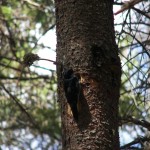
On July 18, 2013, I found an active Black-backed Woodpecker nest site in Minerva (western Essex Co., NY). The male and female were feeding the young inside the nest hole. This indicates the nest is six to seven weeks later than normal for our area.
I initially found this nest hole on May 4, 2013 when the male Black-backed Woodpecker was excavating the cavity. The hole is in a live, mature Tamarack tree approximately 25 feet off the ground. The male finished excavation of the nest hole, but I never found any subsequent evidence of nesting. I visited the location multiple times and spent several hours at the location on June 10, 2013, when I should have observed active feeding of young, as I was observing at other Black-backed Woodpecker nest sites in the Adirondacks. There was no activity near the nest hole that day, and I found a male Black-backed Woodpecker a good distance away. At the time, I wondered if something had happened to the female Black-backed Woodpecker. On other visits in May and early June, I observed the male Black-backed Woodpecker in the general area, but saw no sign of a female or any activity near the nest hole.
As I was hiking the trail in Minerva on July 18, 2013 around noon, a female Black-backed Woodpecker began to call non-stop and the male gave a rattle-call. As I observed the female calling, I also heard the chirring sound of Black-backed Woodpecker young coming from a nest hole. I was surprised to find that the nest hole was indeed used (after all that work on the part of the male in early May!). I made a huge circle around the nesting area so I would not be anywhere near the nest hole. I sat on the mossy ground and just observed the hole from a distance. The female continued to call for a few minutes, but never took the defensive position in the nest cavity. She flew off to forage after a couple minutes. As she came back with food, the male flew in and gave one rattle call as he went into the nest hole with food. After he left, she flew in to feed the young. Black-backed Woodpeckers feed the young inside the nest cavity during their first two weeks of life before the young are old enough to be fed at the hole. The young are typically 24 days old when they fledge. It is likely that the young at this nest will not fledge until the beginning of August! I typically see Black-backed Woodpeckers fledge just after the 3rd week of June. I have already observed family groups of Black-backed Woodpeckers moving around in other locations.
The Birds of North America account for Black-backed Woodpecker states that, “If eggs pilfered, female will lay a second set, often in same nest (Bent 1939).” This may indeed be the case for this nest site, but I never saw evidence of nesting after the male finished the excavation. I will never know exactly what happened earlier in the season. It was certainly quite a surprise to find such a late Black-backed Woodpecker nest today! I will continue to observe them over the next couple weeks.
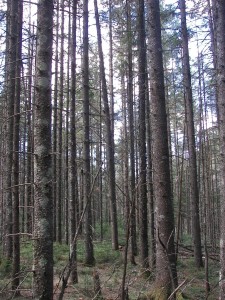
- Male Black-backed Woodpecker excavating a nest hole in a live, mature Tamarack tree about 25 feet off the ground on May 4, 2013.
This blog post provides a list of species found for all Dawn Tours up Whiteface Mountain during June 2013. I have also included photos for some of the trips. All of the trips were full-day outings and included birding in low elevation boreal bogs and forests also.
********
On a weekend tour with two birders from NYC, we spent June 1st in both high and low elevation boreal habitat in the Adirondacks, and June 2nd in the St. Lawrence Valley. We found 72 species on 6/1, and 80 species on 6/2 with a total of 115 different species for the weekend, including 20 warbler species, 11 sparrow species, and 8 flycatcher species. List below:
Saturday, June 1, 2013:
Wild Turkey
Common Loon
Great Blue Heron
Turkey Vulture
Osprey
Broad-winged Hawk
American Kestrel
Wilson’s Snipe
Rock Pigeon
Mourning Dove
Great Horned Owl
Northern Saw-whet Owl
Yellow-bellied Sapsucker
Northern Flicker
Pileated Woodpecker
Eastern Wood-Pewee
Yellow-bellied Flycatcher
Alder Flycatcher
Least Flycatcher
Eastern Phoebe
Blue-headed Vireo
Red-eyed Vireo
Blue Jay
American Crow
Common Raven
Tree Swallow
Cliff Swallow – at their nests!
Barn Swallow
Black-capped Chickadee
Red-breasted Nuthatch
White-breasted Nuthatch
Brown Creeper
Winter Wren
Golden-crowned Kinglet
Ruby-crowned Kinglet
Bicknell’s Thrush
Swainson’s Thrush
Hermit Thrush
American Robin
Cedar Waxwing
Nashville Warbler
Northern Parula
Chestnut-sided Warbler
Magnolia Warbler
Black-throated Blue Warbler
Yellow-rumped Warbler
Black-throated Green Warbler
Blackburnian Warbler
Pine Warbler
Palm Warbler
Blackpoll Warbler
Black-and-white Warbler
American Redstart
Ovenbird
Mourning Warbler
Common Yellowthroat
Canada Warbler
Scarlet Tanager
Chipping Sparrow
Savannah Sparrow
Song Sparrow
Lincoln’s Sparrow
Swamp Sparrow
White-throated Sparrow
Dark-eyed Junco
Rose-breasted Grosbeak
Indigo Bunting
Red-winged Blackbird
Common Grackle
Purple Finch
American Goldfinch
House Sparrow
Sunday, June 2. 2013:
Canada Goose
Trumpeter Swan
Wood Duck
Mallard
Blue-winged Teal
Ring-necked Duck
Greater Scaup
Wild Turkey
Common Loon
Pied-billed Grebe
Double-crested Cormorant
American Bittern
Least Bittern
Great Blue Heron
Green Heron
Black-crowned Night-Heron
Turkey Vulture
Osprey
Northern Harrier
Red-tailed Hawk
American Kestrel
Virginia Rail
Wilson’s Snipe
Ring-billed Gull
Caspian Tern
Common Tern
Black Tern
Rock Pigeon
Mourning Dove
Northern Flicker
Eastern Wood-Pewee
Alder Flycatcher
Willow Flycatcher
Least Flycatcher
Eastern Phoebe
Great Crested Flycatcher
Eastern Kingbird
Yellow-throated Vireo
Blue-headed Vireo
Warbling Vireo
Red-eyed Vireo
Blue Jay
American Crow
Common Raven
Tree Swallow
Barn Swallow
Black-capped Chickadee
Tufted Titmouse
House Wren
Marsh Wren
Veery
American Robin
Gray Catbird
Northern Mockingbird
Brown Thrasher
European Starling
Cedar Waxwing
Blue-winged Warbler – song
Golden-winged Warbler – song
Yellow Warbler
Black-and-white Warbler
American Redstart
Common Yellowthroat
Scarlet Tanager
Eastern Towhee
Chipping Sparrow
Field Sparrow
Savannah Sparrow
Grasshopper Sparrow
Henslow’s Sparrow
Song Sparrow
Swamp Sparrow
Rose-breasted Grosbeak
Indigo Bunting
Bobolink
Red-winged Blackbird
Common Grackle
Baltimore Oriole
American Goldfinch
House Sparrow
We also saw a Mink (at Perch River WMA), a Snowshoe Hare, several Snapping Turtles, and many butterflies & moths, including the Arctic Jutta!
Dawn on June 1st up on Whiteface Mountain’s summit.
*******
On a June 5th tour with a couple from Long Island, we visited both high and low elevation boreal habitat. We found the following 62 species, including 17 warbler species:
Mallard
Common Merganser
Rock Pigeon
Mourning Dove
Belted Kingfisher
Yellow-bellied Sapsucker
Hairy Woodpecker
Black-backed Woodpecker – both the male and female at their nest location
Northern Flicker
Yellow-bellied Flycatcher
Alder Flycatcher
Least Flycatcher
Eastern Phoebe
Blue-headed Vireo
Red-eyed Vireo
Gray Jay – 2 juveniles and 1 adult eating raisins in our hands!
Blue Jay
American Crow
Common Raven
Tree Swallow
Cliff Swallow
Barn Swallow
Black-capped Chickadee
Boreal Chickadee – on Whiteface Mountain during our descent at about 3500’
Red-breasted Nuthatch
Brown Creeper
House Wren
Winter Wren
Golden-crowned Kinglet
Ruby-crowned Kinglet
Eastern Bluebird
Veery
Bicknell’s Thrush (15 to 20) with a few, brief visuals
Swainson’s Thrush (~10)
Hermit Thrush
American Robin
European Starling
Cedar Waxwing
Nashville Warbler
Northern Parula
Chestnut-sided Warbler
Magnolia Warbler
Cape May Warbler
Black-throated Blue Warbler
Yellow-rumped Warbler
Black-throated Green Warbler
Blackburnian Warbler
Pine Warbler
Palm Warbler
Black-and-white Warbler
Blackpoll Warbler
American Redstart
Ovenbird
Mourning Warbler
Common Yellowthroat
Scarlet Tanager
Chipping Sparrow
Song Sparrow
Swamp Sparrow
White-throated Sparrow
Dark-eyed Junco
Common Grackle
Purple Finch
American Goldfinch
A friendly juvenile Gray Jay eating raisins from a hand!
********
On a tour with a young birder and his mother from NYC on June 13th, we visited both high and low elevation boreal habitat. We found the following 71 species, including 17 warbler species:
Canada Goose
Common Merganser
Common Loon – several
Great Blue Heron
Turkey Vulture
Broad-winged Hawk
Rock Pigeon
Chimney Swift
Ruby-throated Hummingbird
Belted Kingfisher
Downy Woodpecker
Hairy Woodpecker
Black-backed Woodpecker – at least 4 adults, and young in a nest hole
Northern Flicker
Yellow-bellied Flycatcher
Alder Flycatcher
Least Flycatcher
Eastern Phoebe
Blue-headed Vireo
Red-eyed Vireo
Gray Jay – at least 10! (2 family groups of at least 5 each)
Blue Jay
American Crow
Common Raven
Tree Swallow
Cliff Swallow – nest colony!
Barn Swallow
Black-capped Chickadee
Boreal Chickadee – 4
Red-breasted Nuthatch
Brown Creeper
Winter Wren
Golden-crowned Kinglet
Ruby-crowned Kinglet
Eastern Bluebird
Bicknell’s Thrush – including a scope view of a singing bird on an open perch!
Swainson’s Thrush
Hermit Thrush
American Robin
Gray Catbird
European Starling
Cedar Waxwing
Nashville Warbler
Northern Parula
Chestnut-sided Warbler
Magnolia Warbler
Black-throated Blue Warbler
Yellow-rumped Warbler
Black-throated Green Warbler
Blackburnian Warbler
Pine Warbler
Palm Warbler
Blackpoll Warbler
Black-and-white Warbler
American Redstart
Ovenbird
Mourning Warbler
Common Yellowthroat
Canada Warbler
Chipping Sparrow
Field Sparrow
Song Sparrow
Lincoln’s Sparrow
Swamp Sparrow
White-throated Sparrow
Dark-eyed Junco
Indigo Bunting
Red-winged Blackbird
Common Grackle
Purple Finch
American Goldfinch
We also found a Porcupine, Snowshoe Hare, Painted Turtle, Deer, and Beaver crying.
Lovely sunrise viewed from Whiteface Mountain’s summit
Bicknell’s Thrush on Whiteface Mountain taken on June 13th
Male Black-backed Woodpecker feeding young on June 13th
Female Black-backed Woodpecker at her nest hole on June 13th
*******
On a tour with four people from Central NY on June 14th, we visited both high and low elevation boreal habitat. We found the following 63 species:
Common Merganser
Turkey Vulture
Osprey
Broad-winged Hawk
American Woodcock
Rock Pigeon
Mourning Dove – in the bog!
Chimney Swift
Ruby-throated Hummingbird
Yellow-bellied Sapsucker
Hairy Woodpecker
Black-backed Woodpecker – 2 adults feeding young at a nest hole!
Northern Flicker
Yellow-bellied Flycatcher
Alder Flycatcher
Least Flycatcher
Eastern Phoebe
Blue-headed Vireo
Red-eyed Vireo
Gray Jay
Blue Jay
American Crow
Common Raven
Tree Swallow
Cliff Swallow – nesting colony
Barn Swallow
Black-capped Chickadee
Boreal Chickadee
Red-breasted Nuthatch
Brown Creeper
Winter Wren
Golden-crowned Kinglet
Ruby-crowned Kinglet
Bicknell’s Thrush – including views!
Swainson’s Thrush
Hermit Thrush
American Robin
European Starling
Cedar Waxwing
Nashville Warbler
Northern Parula
Chestnut-sided Warbler
Magnolia Warbler
Black-throated Blue Warbler
Yellow-rumped Warbler
Black-throated Green Warbler
Blackburnian Warbler
Palm Warbler
Blackpoll Warbler
Black-and-white Warbler
American Redstart
Ovenbird
Mourning Warbler – nice views of a singing bird on a wire!
Common Yellowthroat
Chipping Sparrow
Song Sparrow
Lincoln’s Sparrow – nice views!
Swamp Sparrow
White-throated Sparrow
Dark-eyed Junco
Common Grackle
Purple Finch
American Goldfinch
Blackburnian Warbler on June 14th
A female Black-backed Woodpecker feeding young at her nest hole on June 14th
A baby Black-backed Woodpecker bill sticking out of the nest hole on June 14th
*********
On a tour with three people from Maryland on June 15th, we visited both high and low elevation boreal habitat. We found the following 50 species:
Broad-winged Hawk – carrying a snake!
Barred Owl – calling near the toll gate
Black-backed Woodpecker – 2 adults feeding young at a nest hole
Northern Flicker
Yellow-bellied Flycatcher
Alder Flycatcher
Least Flycatcher
Blue-headed Vireo
Red-eyed Vireo
Gray Jay – 1
Blue Jay
American Crow
Common Raven
Tree Swallow
Cliff Swallow – nest colony – adorable!
Barn Swallow
Black-capped Chickadee
Boreal Chickadee – near the summit on Whiteface
Red-breasted Nuthatch
Brown Creeper
Winter Wren
Golden-crowned Kinglet
Ruby-crowned Kinglet
Eastern Bluebird
Bicknell’s Thrush – lovely views!
Swainson’s Thrush
Hermit Thrush
American Robin
Cedar Waxwing
Nashville Warbler
Northern Parula
Chestnut-sided Warbler
Magnolia Warbler
Black-throated Blue Warbler
Yellow-rumped Warbler
Black-throated Green Warbler
Blackburnian Warbler
Palm Warbler
Blackpoll Warbler
American Redstart
Ovenbird
Mourning Warbler – nice views!
Common Yellowthroat
Chipping Sparrow
Song Sparrow
Swamp Sparrow
White-throated Sparrow
Dark-eyed Junco
Red Crossbill
American Goldfinch
We also saw a Snowshoe Hare on Whiteface and a probable Red-bellied Snake at the bog!
Female Black-backed Woodpecker in a defensive position on June 15th
Female Black-backed Woodpecker feeding young on June 15th
Female Black-backed Woodpecker feeding young on June 15th
Cliff Swallows in their mud nest!
********
On a tour with two people, one from Georgia, and one from Pennsylvania, on June 18th, we visited both high and low elevation boreal habitat. We found the following 61 species:
Osprey
Broad-winged Hawk
Rock Pigeon
Mourning Dove
Belted Kingfisher
Yellow-bellied Sapsucker
Black-backed Woodpecker – 3 adults (one pair) and many young at two nest holes!
Northern Flicker
Yellow-bellied Flycatcher
Alder Flycatcher
Least Flycatcher
Eastern Phoebe
Blue-headed Vireo
Red-eyed Vireo
Gray Jay – 2 adults
Blue Jay
American Crow
Common Raven
Tree Swallow
Cliff Swallow – nest colony
Barn Swallow
Black-capped Chickadee
Boreal Chickadee – 2
Red-breasted Nuthatch
Brown Creeper
Winter Wren
Golden-crowned Kinglet
Ruby-crowned Kinglet
Eastern Bluebird
Bicknell’s Thrush – wonderful view of a singing bird!
Swainson’s Thrush
Hermit Thrush
American Robin
Gray Catbird
European Starling
Cedar Waxwing
Nashville Warbler
Northern Parula
Chestnut-sided Warbler
Magnolia Warbler
Black-throated Blue Warbler
Yellow-rumped Warbler
Black-throated Green Warbler
Blackburnian Warbler
Blackpoll Warbler
Black-and-white Warbler
American Redstart
Ovenbird
Mourning Warbler – nice views!
Common Yellowthroat
Chipping Sparrow
Savannah Sparrow
Song Sparrow
Swamp Sparrow
White-throated Sparrow
Dark-eyed Junco
Bobolink
Common Grackle
Purple Finch
Pine Siskin
American Goldfinch
We also found a Porcupine and several Snowshoe Hare on Whiteface! It was a lovely sunrise with the rivers of fog below!
Bicknell’s Thrush on Whiteface Mountain taken on June 18th
Bicknell’s Thrush on Whiteface Mountain taken on June 18th
Bicknell’s Thrush on Whiteface Mountain taken on June 18th
Male Black-backed Woodpecker at its nest hole on June 18th
*********
On a tour with a person from New Jersey on June 21st, we visited both high and low elevation boreal habitat. We found the following 64 species:
Wild Turkey
Turkey Vulture
Osprey
Broad-winged Hawk
Rock Pigeon
Mourning Dove
Ruby-throated Hummingbird
Belted Kingfisher
Yellow-bellied Sapsucker
Black-backed Woodpecker – 5 adults, many babies (2 nest sites)
Northern Flicker
Yellow-bellied Flycatcher
Alder Flycatcher
Least Flycatcher
Eastern Phoebe
Blue-headed Vireo
Red-eyed Vireo
Blue Jay
American Crow
Common Raven
Tree Swallow
Cliff Swallow – adorable colony!
Barn Swallow
Black-capped Chickadee
Boreal Chickadee – 2 heard
Red-breasted Nuthatch
Winter Wren
Golden-crowned Kinglet
Ruby-crowned Kinglet
Bicknell’s Thrush – with a visual!
Swainson’s Thrush
Hermit Thrush
American Robin
Gray Catbird
European Starling
Cedar Waxwing
Nashville Warbler
Northern Parula
Yellow Warbler
Chestnut-sided Warbler
Magnolia Warbler
Black-throated Blue Warbler
Yellow-rumped Warbler
Black-throated Green Warbler
Blackburnian Warbler
Pine Warbler
Palm Warbler
Blackpoll Warbler
Black-and-white Warbler
American Redstart
Ovenbird
Mourning Warbler
Common Yellowthroat
Chipping Sparrow
Savannah Sparrow
Song Sparrow
Lincoln’s Sparrow
Swamp Sparrow
White-throated Sparrow
Dark-eyed Junco
Common Grackle
Purple Finch
American Goldfinch
House Sparrow
We also found a Porcupine on Whiteface Mountain and a Smooth Green Snake in Bloomingdale Bog!
Mourning Warbler on a wire taken on June 21st
Baby Black-backed Woodpecker head sticking out of its nest hole on June 21st
Lincoln’s Sparrow carrying food for young on June 21st
Smooth Green Snake taken on June 21st
Cliff Swallow babies in their mud nest!
*********
On a tour with two people, one from Florida, and one from NYC, on June 23rd, we visited both high and low elevation boreal habitat. We found the following 69 species:
Common Loon
Osprey
Northern Harrier – lovely male!
Broad-winged Hawk
Merlin
Rock Pigeon
Mourning Dove
Ruby-throated Hummingbird – one was way up on Whiteface Mountain!
Hairy Woodpecker
Black-backed Woodpecker – 2 adults (sadly, a Red Squirrel was actively predating their nest site when we arrived) and we heard the loud young in another nest hole – hopefully, they will make it.
Northern Flicker
Yellow-bellied Flycatcher
Alder Flycatcher
Least Flycatcher
Eastern Phoebe
Blue-headed Vireo
Red-eyed Vireo
Gray Jay – 5 (one family group of at least 4 – 2 adults and 2 juveniles; and 1 juvenile)
Blue Jay
American Crow
Common Raven
Tree Swallow
Cliff Swallow – nest colony – adorable!
Barn Swallow
Black-capped Chickadee
Red-breasted Nuthatch
Brown Creeper
Winter Wren
Golden-crowned Kinglet
Ruby-crowned Kinglet
Eastern Bluebird
Veery – one in boreal habitat
Bicknell’s Thrush – nice visual!
Swainson’s Thrush
Hermit Thrush
American Robin
European Starling
Cedar Waxwing
Nashville Warbler – nice view!
Northern Parula
Chestnut-sided Warbler
Magnolia Warbler
Black-throated Blue Warbler
Yellow-rumped Warbler
Black-throated Green Warbler
Blackburnian Warbler
Pine Warbler
Palm Warbler – nice views at the bog!
Blackpoll Warbler
Black-and-white Warbler
American Redstart
Ovenbird
Northern Waterthrush
Mourning Warbler – nice view!
Common Yellowthroat
Canada Warbler
Chipping Sparrow
Savannah Sparrow
Song Sparrow
Lincoln’s Sparrow – nice views at the bog!
Swamp Sparrow
White-throated Sparrow
Dark-eyed Junco
Indigo Bunting – lovely view!
Bobolink – nice view
Red-winged Blackbird
Common Grackle
Purple Finch
American Goldfinch
We also found Snowshoe Hares and Hummingbird Moths!
Lincoln’s Sparrow taken on June 23rd
Lincoln’s Sparrow taken on June 23rd
Lincoln’s Sparrow taken on June 23rd
Lincoln’s Sparrow taken on June 23rd
Lincoln’s Sparrow taken on June 23rd
After the rain on June 23rd, we found a wet, singing Nashville Warbler!
********
On a tour with three people, two from Texas, and one from Pennsylvania, on June 26th, we visited both high and low elevation boreal habitat. We found the following 64 species:
Common Loon
Great Blue Heron
Broad-winged Hawk
Rock Pigeon
Mourning Dove
Yellow-bellied Sapsucker
Hairy Woodpecker
Black-backed Woodpecker – 2 heard
Yellow-bellied Flycatcher
Alder Flycatcher
Least Flycatcher
Eastern Phoebe
Blue-headed Vireo
Red-eyed Vireo
Gray Jay – at least 8 (groups of 3, 2, 3) – nice views, including juveniles
Blue Jay
American Crow
Common Raven
Tree Swallow
Barn Swallow
Red-breasted Nuthatch
Brown Creeper
House Wren
Winter Wren
Golden-crowned Kinglet
Ruby-crowned Kinglet
Eastern Bluebird
Veery
Bicknell’s Thrush – nice scope views!
Swainson’s Thrush
Hermit Thrush
American Robin
Gray Catbird
European Starling
Cedar Waxwing
Nashville Warbler – quick view!
Northern Parula
Chestnut-sided Warbler
Magnolia Warbler
Black-throated Blue Warbler
Yellow-rumped Warbler
Black-throated Green Warbler
Blackburnian Warbler
Palm Warbler
Blackpoll Warbler
Black-and-white Warbler
American Redstart
Ovenbird
Mourning Warbler
Common Yellowthroat
Canada Warbler
Chipping Sparrow
Savannah Sparrow
Song Sparrow
Lincoln’s Sparrow –nice view!
Swamp Sparrow
White-throated Sparrow
Dark-eyed Junco
Indigo Bunting
Bobolink – nice scope view!
Common Grackle
Purple Finch
American Goldfinch
Bicknell’s Thrush on Whiteface Mountain taken on June 26th
**********
On a tour with a person from Pennsylvania on June 30th, we visited both high and low elevation boreal habitat (including a very remote lowland boreal area). We found the following 71 species, including 18 warbler species:
Ruffed Grouse – hen with young (at least 3)
Osprey
Northern Harrier – female
Broad-winged Hawk
Mourning Dove
Chimney Swift
Belted Kingfisher
Hairy Woodpecker
Black-backed Woodpecker – 2 (a nice view of a male)
Northern Flicker
Pileated Woodpecker
Olive-sided Flycatcher – nice view and great vocalizations!
Yellow-bellied Flycatcher – both high and low elevation boreal habitat
Least Flycatcher
Blue-headed Vireo
Red-eyed Vireo
Gray Jay – 6 (2 juveniles, and a family of at least 4)
Blue Jay
American Crow
Common Raven
Tree Swallow
Barn Swallow
Black-capped Chickadee
Boreal Chickadee – heard at Bloomingdale Bog
Red-breasted Nuthatch
Brown Creeper
House Wren
Winter Wren
Golden-crowned Kinglet
Ruby-crowned Kinglet
Eastern Bluebird
Bicknell’s Thrush – 2 fly-by views!
Swainson’s Thrush
Hermit Thrush
American Robin
Gray Catbird
European Starling
Cedar Waxwing
Nashville Warbler – nice views!
Northern Parula
Chestnut-sided Warbler
Magnolia Warbler
Black-throated Blue Warbler
Yellow-rumped Warbler
Black-throated Green Warbler
Blackburnian Warbler – nice views!
Pine Warbler
Palm Warbler – nice views!
Blackpoll Warbler
Black-and-white Warbler
American Redstart – views!
Ovenbird
Northern Waterthrush
Mourning Warbler – terrific views!
Common Yellowthroat
Canada Warbler – carrying food
Scarlet Tanager
Chipping Sparrow
Savannah Sparrow
Song Sparrow
Lincoln’s Sparrow – nice views!
Swamp Sparrow
White-throated Sparrow
Dark-eyed Junco
Rose-breasted Grosbeak
Indigo Bunting
Bobolink
Red-winged Blackbird
Common Grackle – family group
Purple Finch
Red Crossbill – flyover bird vocalizing
We also found a Porcupine, 3 River Otters, a doe with a fawn, Snowshoe Hares, Red Squirrels, a Raccoon, and a possible Black Bear!
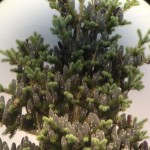
Cones provide food for many animals, including winter finches. Watching this developing food source across the northeastern U.S. and Canada can help us predict winter movements (irruptions) of certain species, particularly winter finches. If the cone crops are poor to our north, while our cone crops are good, then we can expect finch species to move into our area for the winter. Last winter (2012-2013), was a poor year for our area, and finches moved far to the south – with reports from as far away as Georgia! Crossbills filled Long Island and Central Park in NYC! Our resident Evening Grosbeaks, which form large flocks in our town during winter (I usually have over a hundred feeder birds) completely left the Adirondacks last winter.
Now that I have the iPhone-Kowa scope adapter, I have been able to take close-up photographs of this year’s cone crops. All spruce species (Black, Red, White, Norway), Balsam Fir, and White Pine look excellent! Tamarack and Eastern Hemlock look good. I have not yet been able to photograph White Cedar. Red Pine appears to have some maturing cones – tough to photograph this species. Scotch Pine has many new cones this year.
Here are the photos (if you click twice on each photo, you can view a larger image):
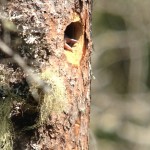
In early May, I found a couple different Black-backed Woodpecker nest sites. The male does all the excavation of the nest hole, which can be in a live tree, dead snag, or even a telephone pole! I have observed nests that ranged from 15 feet above the ground to 65 feet above the ground. One particular nest location this year was in a dead snag about 15 feet above ground. I frequently observed this nest site with clients over the past couple months. It was discovered by many local birders and people frequented the location daily, including folks out walking their dogs.
The male not only does all of the excavation, but he does all of the nighttime incubation and almost all of the fecal sac removal to keep the nest hole clean once the young are born. It was lovely to see how hard both parents worked to constantly feed the very loud nestlings! Black-backed Woodpecker young vocalize non-stop with a constant churring noise coming from the nest hole. You wonder how they survive when they make so much noise. The vocalizations became louder as adults flew in with food – so we would spend time talking and as the young became louder, it would alert us to another feeding session. When the young are big enough, the parents feed them by leaning in the hole. I ended up with lots of photographs of the baby heads sticking out seeking food. I observed two heads, and one client saw three heads at the hole. (They typically have 3 to 4 young.)
I observed a couple of interesting behaviors to note. The parents would sometimes give a softer version of their “kyik” call note and the young would immediately fall silent in the nest hole. It was apparent that it was a signal to be quiet. Also, several times the female Black-backed Woodpecker entered the hole and stuck her head out – sometimes with the bill sticking straight out and sometimes with her head and bill pointed down. This behavior would usually last about 15 to 20 minutes and the young would be completely silent during this period. It appeared to me that she feared a predator and was in a defensive position. Larry Master also noted this behavior when he visited the nest site, and said that he, too, noticed it was the female that was in a defensive position. Larry said that a couple of Common Grackles tried to predate the nest and that the Black-backed Woodpecker adults chased them off. Sean O’Brien once observed a Black-backed Woodpecker in this defensive position inside a nest hole that nailed the face of a Red Squirrel attempting to predate a nest in the same area.
On June 23, 2013, I was with a couple clients and we hiked to the Black-backed Woodpecker nest site. I was a bit concerned as we approached the nest and I did not hear the churring of the young. I set up my scope to view the nest hole, which is out in a swamp area, and I looked into the scope and viewed a Red Squirrel face looking out of the nest hole. I felt sick at the sight. After nearly two months of non-stop work by both parents, they were frantic. The male drummed non-stop on a dead snag next to the nest hole tree, and the female kept flying in to try and peck the squirrel, but she kept flying up as the squirrel would lunge at her. They called – both their short calls and the rattle call. It was an awful scene. We tried different things to get the squirrel to come out of the hole, but it was futile. My clients said they couldn’t stand to watch it any longer so we left. There were no sounds of the young. The young would have fledged in just a few days and they would have continued to be fed by the adults outside the nest. Young in a nest are so helpless, and it was so disturbing to see such a tragic end for these woodpecker babies. Some of the photographs I took over two months are below.
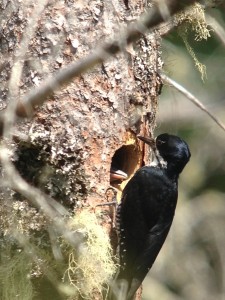
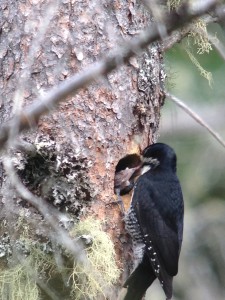
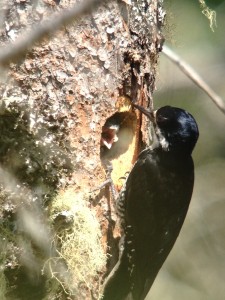
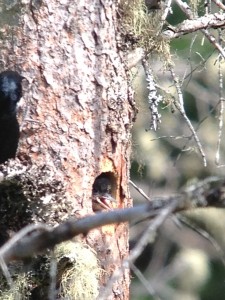
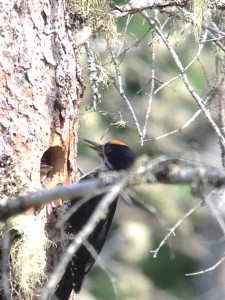
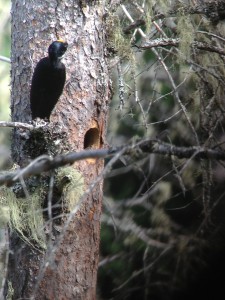
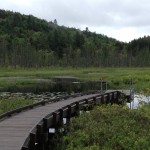
The 9th annual Adirondack Birding Festival was held this past weekend from June 7th to June 9th. Many birders return year after year for this event, and it is always wonderful to see familiar faces on the field trips! The Hamilton County Department of Economic Development & Tourism organizes the event each year. Field trips are spread across large Hamilton County and areas surrounding the county. There is no registration fee to attend, and the county assists birders with where to stay depending on their registered field trip locations. Next year will mark the 10th year of the Adirondack Birding Festival and there will be even more field trips added as this event continues to grow each year.
Dr. Bruce Beehler, of Conservation International, returned again this year and helped lead field trips in addition to speaking on Saturday evening. The presentation featured a fascinating mix of Dr. Beehler’s extensive knowledge of conservation issues and spectacular bird photos from around the world.
I led trips at Ferd’s Bog, Brown’s Tract Inlet, Low’s Ridge/Upper Dam Trail, and Moose River Plains. It was raining at Ferd’s Bog, so things were fairly quiet on that hike! (A participant re-visited the bog on Sunday afternoon and confirmed that Olive-sided Flycatchers are nesting there again this year!) The rain let up as we transitioned to Brown’s Tract Inlet (photos included). Just before the long, lovely board-walk (a canoe put-in, but terrific for birders!), we had great views of a Canada Warbler and Northern Waterthrush. Low’s Ridge/Upper Dam Trail was a hit with participants. We found 16 warbler species and had nice scope views of a singing Lincoln’s Sparrow in the bog section of the hike. The highlight was watching the “changing of the guard” at a Common Loon nest as the adults changed places in their typically awkward way! A large Snapping Turtle was observed laying eggs near the Upper Dam on the Bog River. At Moose River Plains we had lovely scope views of a singing Blackburnian Warbler perched at the top of a spruce tree. Boreal Chickadees were heard (one participant had a view), but remained mostly hidden as they are actively nesting. It was particularly exciting this year to have a new birder on this field trip who showed tremendous enthusiasm for every bird she viewed! Sixty-four species were tallied on these particular field trips.
There is a great deal of talk regarding the lack of neotropical migrants in our area this year. Breeding Bird Survey (BBS) data will probably shed more light on birders’ observations. Lincoln’s Sparrow, a bird that is usually abundant in bogs, is virtually missing! We found only one Lincoln’s Sparrow along the mile-long, huge bog on the Low’s Ridge/Upper Dam Trail – where you would normally find many. (It is the same situation in other bogs I frequent.) We found none at Ferd’s Bog and Brown’s Tract Inlet. Indigo Buntings are hard to find this year, as are Veeries, and Rose-breasted Grosbeaks. The numbers of birds appear to be way down, with an eerily quiet dawn chorus. One of the potential reasons was extreme weather events occurring as migrants were making their way around or over the Gulf of Mexico. Additional time and data will hopefully shed light on this worrisome situation.
Once again this year, several field trip leaders spent the weekend at our home. Between early field trips, meals, and nighttime discussions of classical music, literature, and of course birds(!), it was a sleepless weekend! My 18 year-old informed me that I hang out with very interesting people! I would agree that birders are fascinating folks!
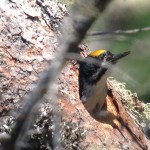
When I lead dawn tours up Whiteface Mountain, I rise at 1 a.m. and leave the house at 2:30 a.m. Some clients stay in Long Lake and we do some nocturnal birding together along the way, and some choose to stay closer to Whiteface so they can sleep longer! I am often asked how I can get up so early. There are wonderful benefits to being up during the night. For instance, on June 5th, I got up at 1 a.m. and heard noises outside. It was an Ermine (or Short-tailed Weasel) running around our front lawn! I also found a Luna Moth perched on our home (photograph included) and heard a fox vocalizing in the forest. During my drives to Whiteface, I find many nocturnal creatures such as Red and Gray Foxes, Eastern Coyotes, Porcupines, Raccoons, Deer, Fishers, and Minks. At stops with clients we often hear owls: Barred Owls, Northern Saw-whet Owls, and Great Horned Owls, and other species such as Beavers, Ruffed Grouse, Wilson’s Snipe, American Woodcock, Common Loons, and American Bitterns. On June 5th, as I approached Whiteface Mountain in the pre-dawn glow, there was a sliver moon over the majestic mountain and it was breathtaking. I spent the day with a couple from Long Island, NY and the day had perfect weather conditions. It was very cold on the summit of Whiteface Mountain at dawn, so we had no insects to bother us! We found 62 species (including 17 warbler species) by visiting Whiteface Mountain, Bloomingdale, and Lake Placid – species listed below:
Mallard
Common Merganser
Rock Pigeon
Mourning Dove
Belted Kingfisher
Yellow-bellied Sapsucker
Hairy Woodpecker
Black-backed Woodpecker – both the male and female at their nest location (photo included)
Northern Flicker
Yellow-bellied Flycatcher
Alder Flycatcher
Least Flycatcher
Eastern Phoebe
Blue-headed Vireo
Red-eyed Vireo
Gray Jay – 2 juveniles and 1 adult eating raisins from hands! (photo included)
Blue Jay
American Crow
Common Raven
Tree Swallow
Cliff Swallow – adorable nest sites!
Barn Swallow
Black-capped Chickadee
Boreal Chickadee – lovely scope views on Whiteface Mountain during our descent at about 3500’
Red-breasted Nuthatch
Brown Creeper
House Wren
Winter Wren
Golden-crowned Kinglet
Ruby-crowned Kinglet
Eastern Bluebird
Veery
Bicknell’s Thrush (15 to 20) with a few, brief visuals
Swainson’s Thrush (~10)
Hermit Thrush
American Robin
European Starling
Cedar Waxwing
Nashville Warbler
Northern Parula
Chestnut-sided Warbler
Magnolia Warbler
Cape May Warbler – lovely views of one!
Black-throated Blue Warbler
Yellow-rumped Warbler
Black-throated Green Warbler
Blackburnian Warbler
Pine Warbler
Palm Warbler
Black-and-white Warbler
Blackpoll Warbler
American Redstart
Ovenbird
Mourning Warbler
Common Yellowthroat
Scarlet Tanager
Chipping Sparrow
Song Sparrow
Swamp Sparrow
White-throated Sparrow
Dark-eyed Junco
Common Grackle
Purple Finch
American Goldfinch
I greatly enjoy the dawn tours up Whiteface Mountain because I am fascinated by high elevation bird species and it is always lovely to be awake during the Adirondack nights!
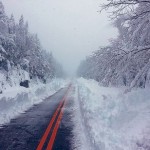
After 5 days away in northern Michigan, I arrived back home in the Adirondacks on Sunday evening of Memorial Day Weekend. I was half-listening to CNN news Monday morning, when I registered “Whiteface Mountain” and “3 FEET of snow”! I rewound the news hoping I incorrectly heard it. Five inches of rain had fallen in the lower elevations of the Adirondacks, and at higher elevations, it was snow – a great deal of snow in a short amount of time. Temperatures were in the 30s at lower elevations and as is usually the case, it was no doubt at least 10 degrees colder in the higher elevations.
I have had calls and email messages asking about Bicknell’s Thrush and how it could be faring. On May 19th I found many Bicknell’s Thrushes back, and many other species holding territories on Whiteface Mountain’s summit area. I immediately thought about the implications of such a severe weather event for all the species at high elevations. I thought about the female Bicknell’s Thrushes just returning, depleted from their long journey, arriving into a world of cold and snow. One person suggested that all the birds could simply move to lower elevations and wait out the snow melt. I highly doubt that these territorial species will leave their breeding grounds, and I suspect the event will end up taking a heavy toll on many of the birds. I recall a late April storm over a decade ago when we received a sudden two-foot snowfall. An American Woodcock ended up on someone’s porch in town (the only place it could find without snow). I called a rehabilitator friend and she immediately picked up the bird, but its weight was half of what it should have been. She tried to save the bird for 3 days, but it died. There is no doubt that many other birds died from that severe weather event. If only it was as simple as having all the birds temporarily move to a snowless place, but it just doesn’t work that way! I have observed thrushes, in particular American Robins and Hermit Thrushes, gather on plowed roadways when we’ve had late snow events. The Whiteface Mountain manager informed me that they were plowing the road and hoped to have it re-open right away. So I hope the snow-free roadway provides a place for Bicknell’s and Swainson’s Thrushes, American Robins (yes, there are actually nesting robins on Whiteface!), and other high elevation species to find food to get through this severe weather event. But only one mountain in the Adirondacks has a road, and all the other High Peaks are buried in deep snow. I have observed Bicknell’s Thrush appearing to fare well when we have received early October snowstorms before their fall migration – but not in THREE feet of snow!
A sarcastic comment was made on a recent group email message (not a birding group) about the heavy, late snowfall in the Adirondacks and how the person thought our problem was “global warming”. The ignorance in such statements is greatly troubling. While we can never prove that any one extreme weather event is the direct result of global warming, we can certainly look at the patterns and trends. Extreme weather events are becoming more frequent and more severe as we continue to add CO2 to the atmosphere at an unprecedented rate. The extreme weather graph mimics the Keeling Curve, and I might add, the world population curve also. (There were 3 billion people on the planet when I was born, and if I live to my life-expectancy, it will be 9 billion – a TRIPLING in one lifetime.) A warming planet will greatly increase the chances of extreme weather events. You would have to have your head in the sand not to notice this is already the case.
Each year, I become more worried climbing up the mountains and wondering what changes I will observe from the prior year. The rate of species expansion upslope is astounding. This year, Black-throated Green and Black-throated Blue Warblers are holding territories well over 4,000 feet on Whiteface Mountain – something that would not have been the case a decade ago. I tallied twice as many Swainson’s Thrushes during the Mountain Birdwatch survey of Whiteface Mountain in 2012 – again, something that would not have been the case a decade ago. (Scientists believe that the warming spring temperatures have allowed Swainson’s Thrushes to rapidly expand their breeding range upward in elevation – and become a potential competitor with Bicknell’s Thrush.) The steep decline in Bicknell’s Thrush numbers I’ve observed in the past couple years is particularly troubling. Observing such rapid ecological changes on the mountains over the course of a mere decade is like someone holding up a magnifying glass to climate change effects, and it is a frightening image.
Not a day goes by that I don’t think about my own unintended complicity in our warming planet, and the resulting harm done to other species, including extinction for some. In a talk that I give on climate change, I have a slide with photos depicting the typical U.S. lifestyle – two cars, 24-7 access to electricity, seemingly unlimited appliances to simplify our lives, a big (heated or cooled) home, air travel, and stores filled with a myriad of food choices, some shipped thousands of miles from around the world – all spewing CO2 into the atmosphere. I think you get the picture. We grew up with this lifestyle and no one wants to give it up. But our lifestyle is inflicting great harm on the life forms of our planet – including humans. Humans have changed the composition of the atmosphere enveloping Earth, which is a terrifying reality. As a result, the world in which our current life forms evolved is rapidly changing. Extreme weather events take a huge toll. For birds, it can hamper nesting (as 5 inches of rain and 3 feet of snow no doubt did this past weekend), and this year, bird migration was even more perilous as birds encountered extreme weather events (including changing wind patterns) when they were already depleted from such exhausting travel – resulting in a huge number of fatalities.
To leave this blog post on a more positive(!) note, I recently heard the tail-end of a piece on National Public Radio highlighting the work of a number of PhD students working on climate change. They are receiving millions of dollars for their research on artificially creating a photosynthesis process to take CO2 out of the atmosphere. It was the most hopeful news I’ve heard in a long time. There are many complications in their work, and their potential solution will take time, but it was so heartening to hear of young people concerned about climate change and working hard to find a solution. I hope they hurry.
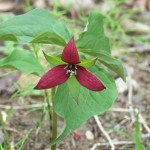
May, June, and July are wonderful months to look for wildflowers in the Adirondacks. For a wide diversity of wildflower species, look for trails in old growth deciduous forests. On an afternoon wildflower tour with a couple from Philadelphia, PA on May 14th this week, we found twenty wildflower species hiking a half-mile section of trail. Here is our list:
Hobblebush
Early Fly Honeysuckle
Two-leaved Toothwart
Painted Trillium
Purple Trillium
False Solomon’s Seal
Hairy Solomon’s Seal
Smooth Solomon’s Seal
Wild Sarsaparilla
Canada Mayflower
Starflower
Foamflower
Goldthread
Carolina Spring Beauty
Jack-in-the-pulpit
Trout Lily
Clintonia
Canada Violet
YellowViolet
Marsh Blue Violet
Bluets (at the home the couple rented)
We also visited a Black-backed Woodpecker nest site, where the male was still busy excavating the nest hole. He was inside the cavity and occasionally stuck his head out of the hole to shake away wood shavings! The female was foraging nearby.
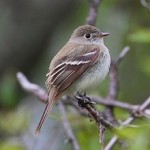
The Least Flycatcher has an unusual behavior among passerines. It forms “aggregations” or “clusters”. In the spring, males establish small territories among a dense cluster of Least Flycatchers, which is reminiscent of a lek mating system.
Least Flycatchers breed in deciduous, and mixed coniferous and deciduous, forests. The largest aggregations of Least Flycatchers that I have observed occur at forest openings. There is a large aggregation outside our house where there are several open acres surrounded by mixed forest, and on the way into Massawepie Mire where there is also a large, circular opening in the forest. Males give their loud “chebec” song all around the forest opening. They have a softer, almost “grumbled”, or also referred to as “guttural”, “speetz” call they give when changing perch locations.
Why do Least Flycatchers form aggregations when most other passerines do not nest in such social groups and establish their own, larger territories? There are several theories, some of which include: female preference for clustered males and pursuit of extra-pair matings, clustering may reduce nest predation, and one that I find intriguing, the open areas near forest aggregations may be neutral feeding grounds used by all the members of the cluster, which reduces conflict and allows for decreased territory sizes.
Least Flycatchers are often described as “pugnacious” and aggressive toward other species. They continuously attack other species when their territories overlap. This aggressive behavior in a cluster of birds may certainly support the theory of reduced nest predation among birds in aggregations.
Further study is needed to fully explain why Least Flycatchers nest in social clusters.
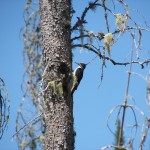
May is a fascinating month to be birding in the Adirondacks! The excavators are busy hollowing out tree space to raise young. In the past week, I have found two Black-backed Woodpecker nest sites, a Red-breasted Nuthatch nest, a Black-capped Chickadee nest, two likely Boreal Chickadee nest locations, and countless Yellow-bellied Sapsucker nests! The Jeopardy category would be titled “species that excavate nest holes”. Early to mid May is the best time to hear the sounds of the excavating activity.
Black-backed Woodpecker males do all the work of excavating a nest cavity. A male will change locations with the female long enough for her to inspect the nest hole before the male continues his non-stop work. Once the work takes him entirely inside the cavity, he occasionally sticks his head out to shake away the wood shavings.
The diversity of Black-backed Woodpecker nest site locations is remarkable. Last year, a pair nested 55 to 60 above the ground in a live Red Spruce tree on a hill. Two other nest hole locations observed that year were about 15 to 20 feet up in dead snags. These two other locations shared a commonality of a wet area filled with dead trees. Another birder observed a Black-backed Woodpecker nest hole in a telephone pole! This year, the first nest found is in a location with mature spruce trees on a hill. The nest is in a tall dead tree among live spruces. The hole is about 25 to 30 feet off the ground. The second nest found is in a wet area of dead snags. The nest hole is about 15 feet off the ground.
Late yesterday afternoon, on May 9, 2013, I ventured out at 4 p.m. to check the area where I had found the nest in a live Red Spruce last year. I immediately heard a Black-backed Woodpecker calling, and found a foraging female. I spent the next 3 hours sitting on the forest floor observing a pair that intermittently foraged and mated three times! They were continuously calling to each other as they foraged and then, as their vocal activity increased, I knew I would see mating again. The Black-backed Woodpeckers increase the frequency of their short calls and then start giving the longer rattle calls as the male flies in to mate with the female on a branch (usually close to the trunk). The male has a very distinctive flight as he approaches the female to mate – a slower, more fluttering, stiff flight pattern. After mating, the male flies away and the female remains on the branch for a short time before going back to foraging. Male Black-backed Woodpeckers actively mate with females during the course of excavating a nest hole. As I was noting the date, it suddenly occurred to me that it was the same date that I observed mating at this location last year – and it was likely the same pair! I have yet to find their new nest location.
On May 7, 2013, I heard a Boreal Chickadee calling at me, so I bushwhacked to the source of the sound. As I always do, I sat down on the mossy ground and tried to be inconspicuous (as much as a human can be…). The Boreal Chickadee continued to vocalize and I wondered if I would discover a nest hole. After awhile, a second Boreal Chickadee arrived and immediately began to inspect the dead trees around me. It continued to make its way closer and closer to me. I remained like a statue. I could hear it behind me a few feet, when suddenly I felt it attempt to land on me! I could feel the swoosh of the wings fluttering over my head. As much as I tried to stay still, it made me flinch, and the bird flew in front of me into a bush about two feet from my face! I have always found Boreal Chickadees to be extremely curious birds, but having one almost land on me was a first!
- Nest hole 25 to 30 feet off ground in dead conifer among live spruces.
- Closer view of the excavating male.
- Nest hole 15 feet off the ground in a dead snag.
- Live Red Spruce where a Black-backed Woodpecker excavated a nest hole 55 to 60 feet off the ground.
